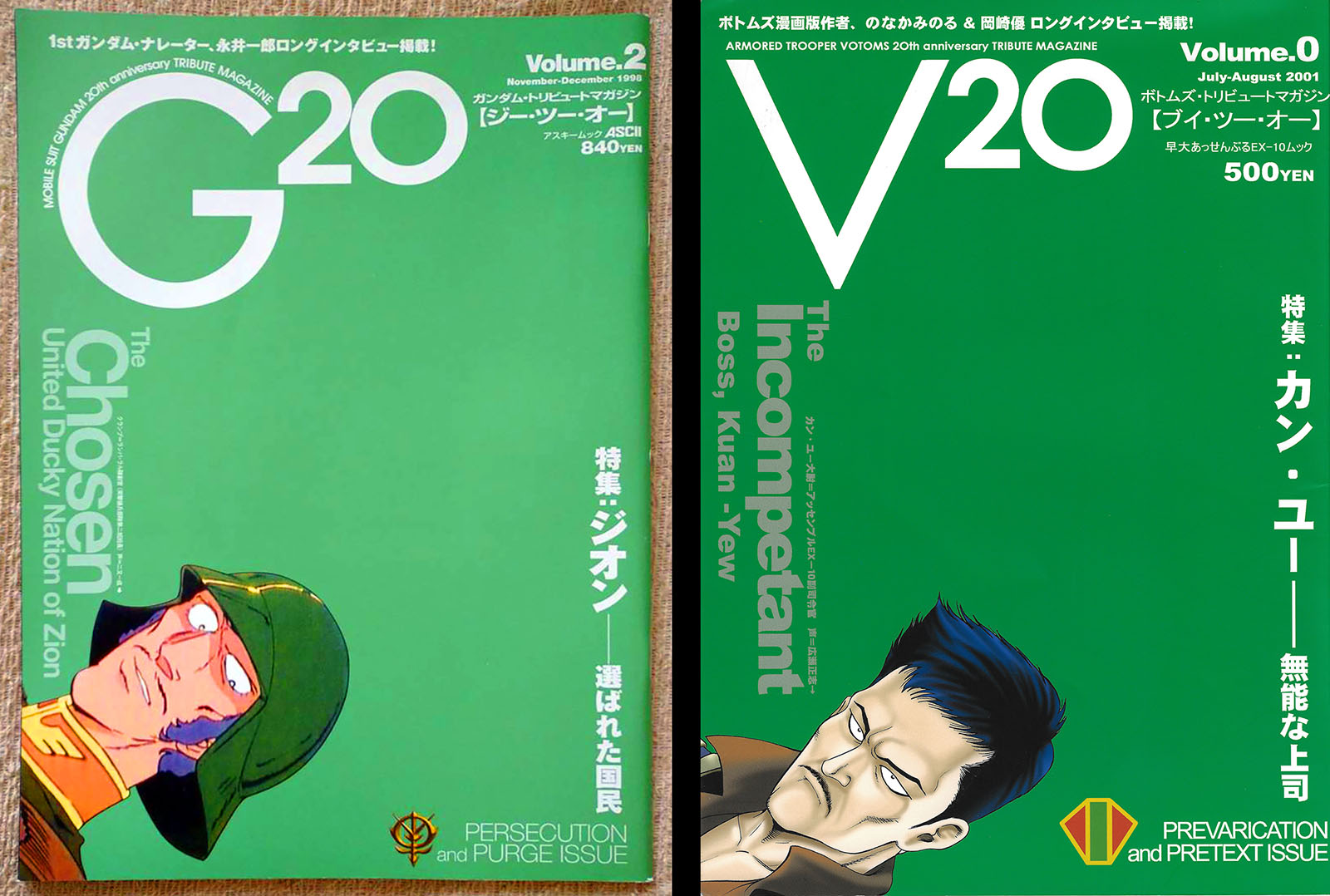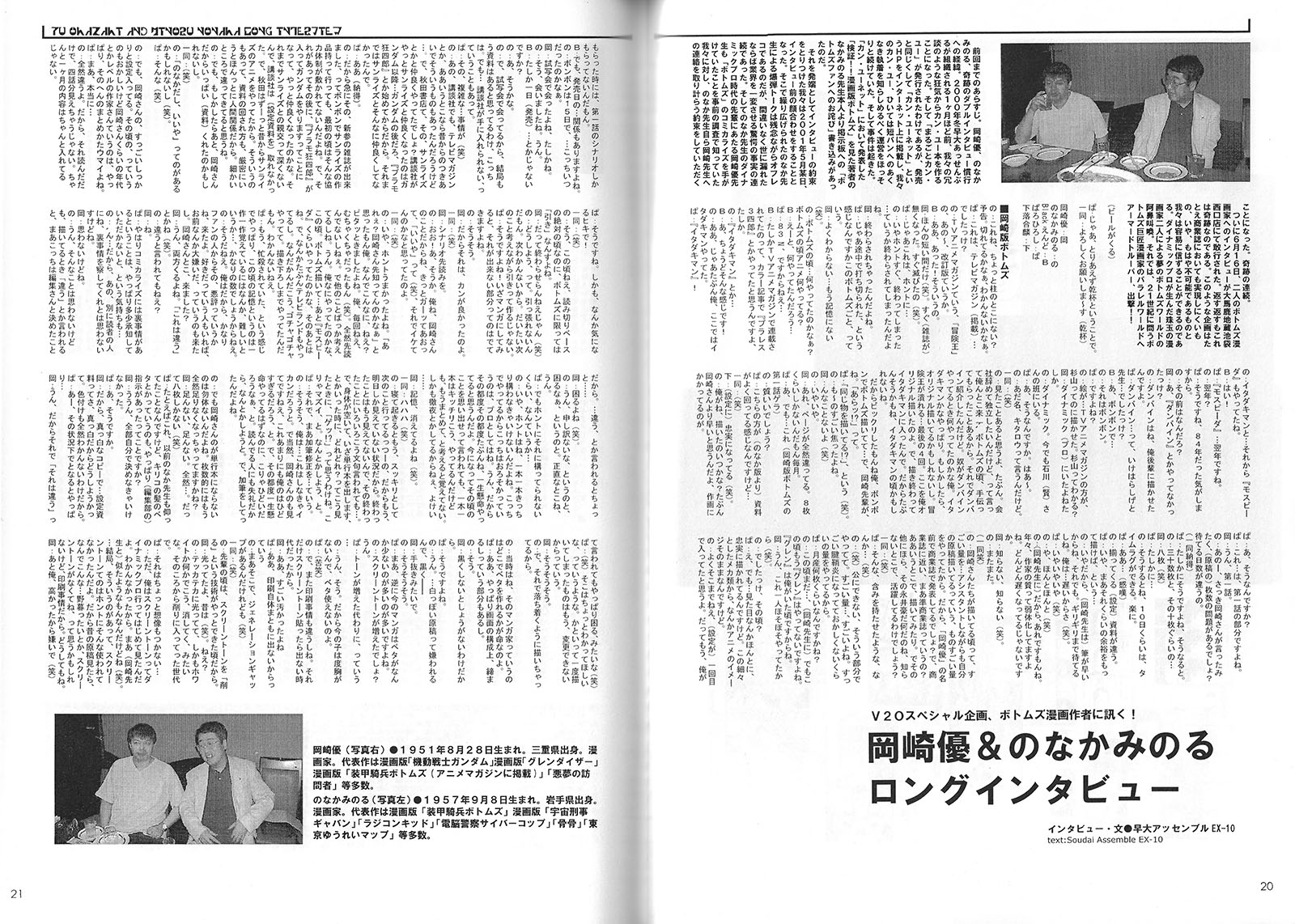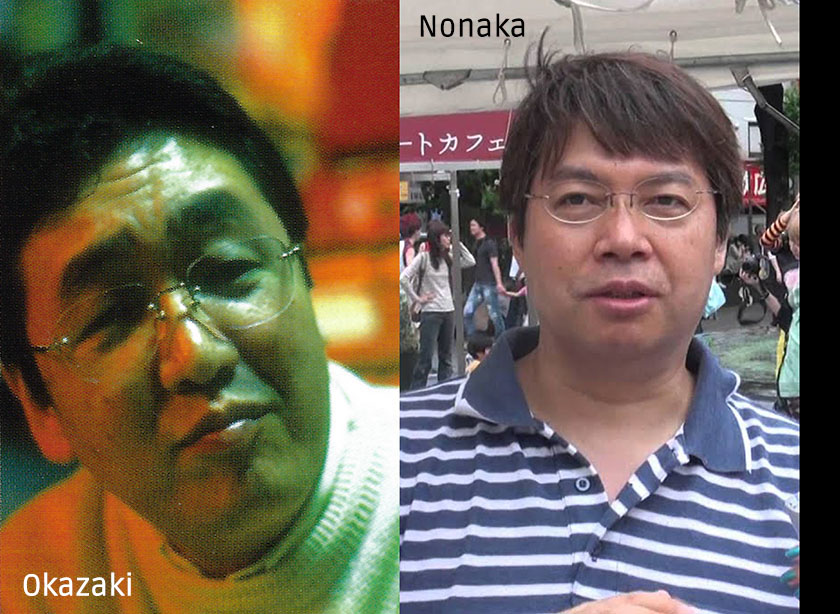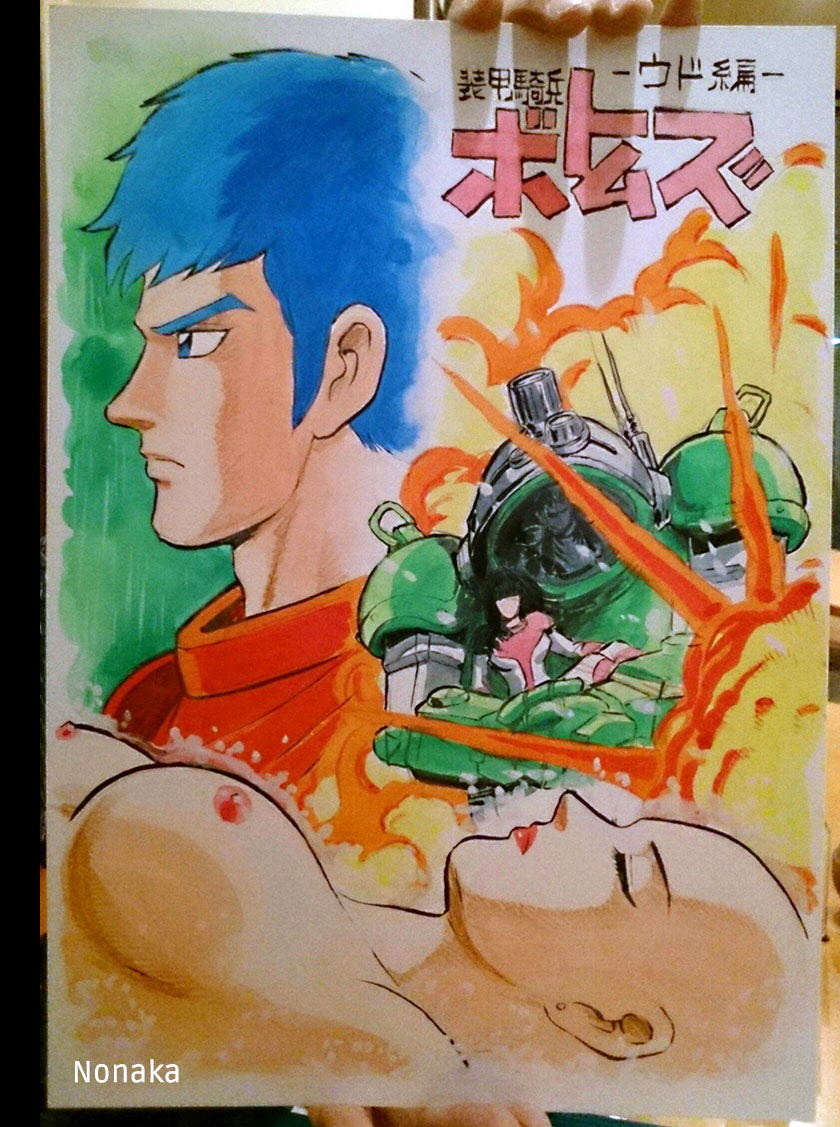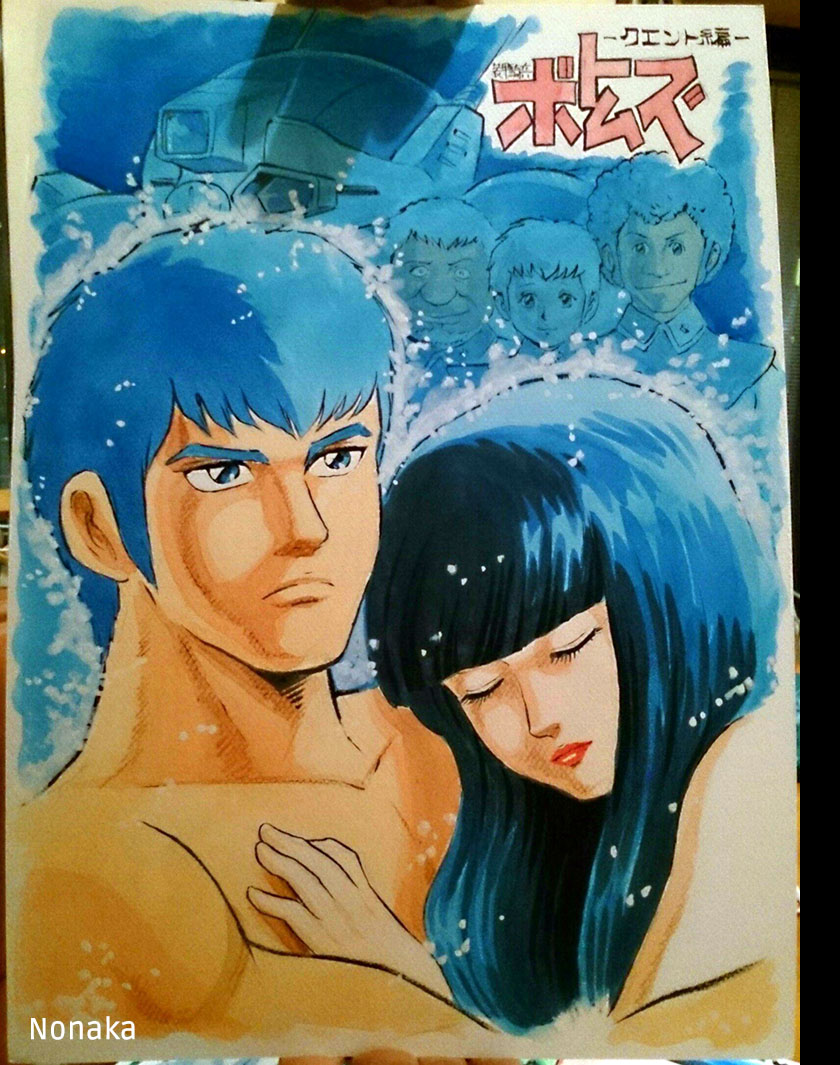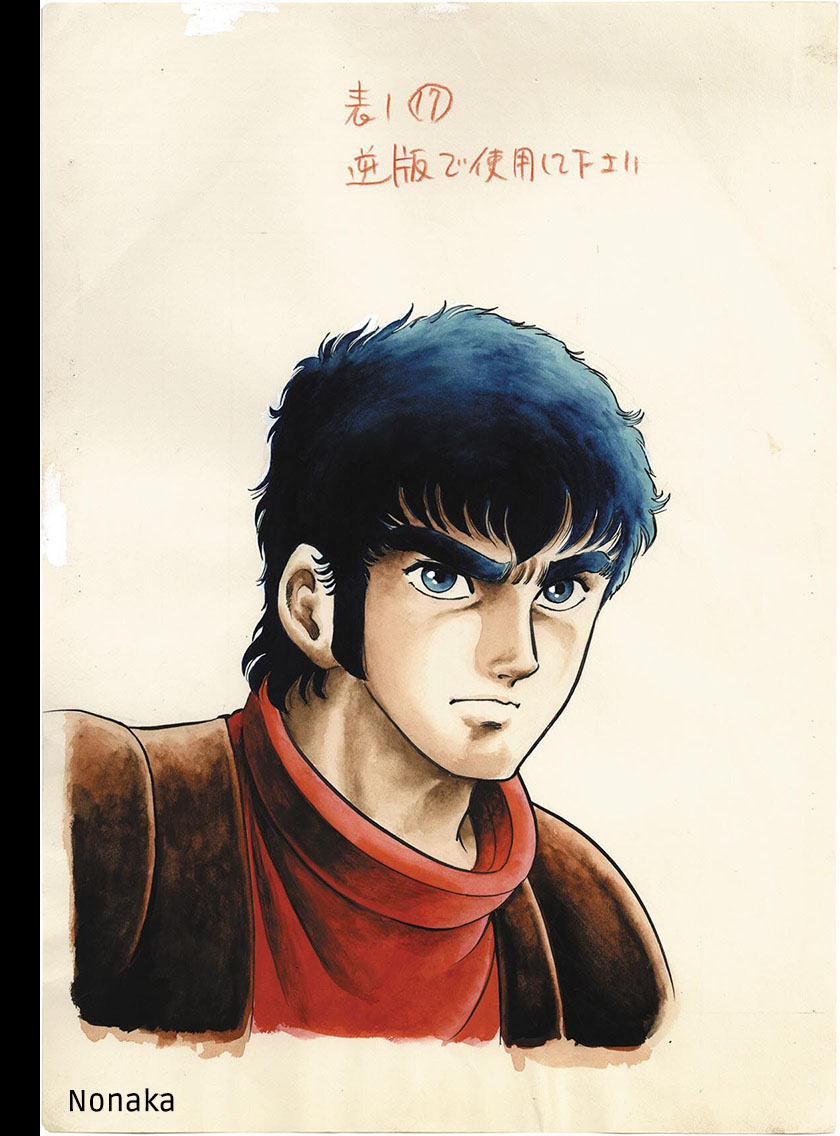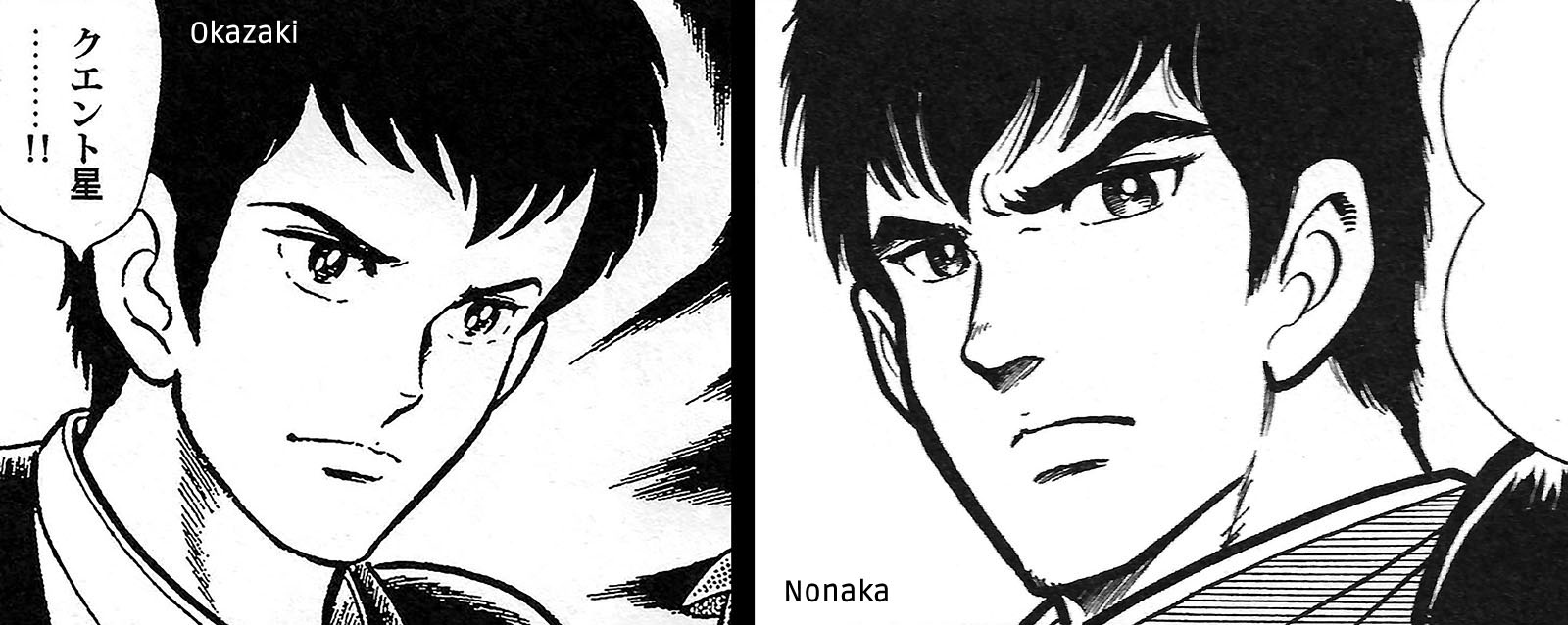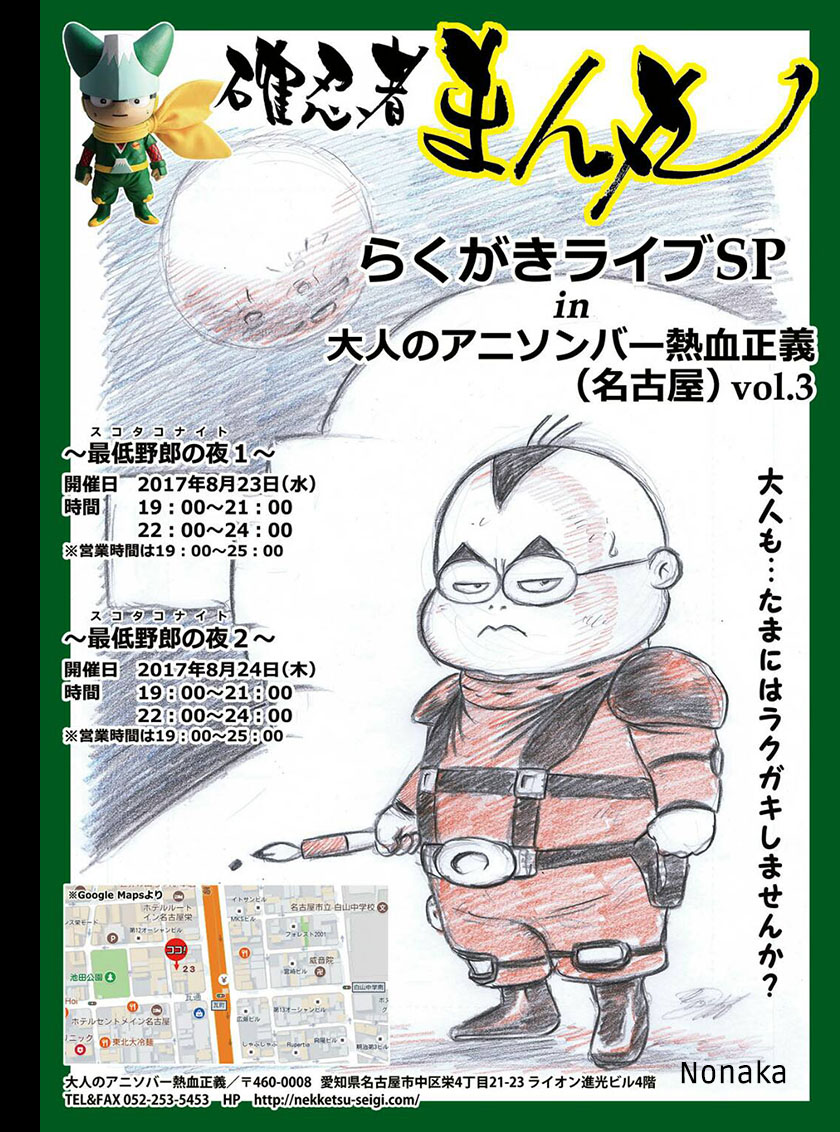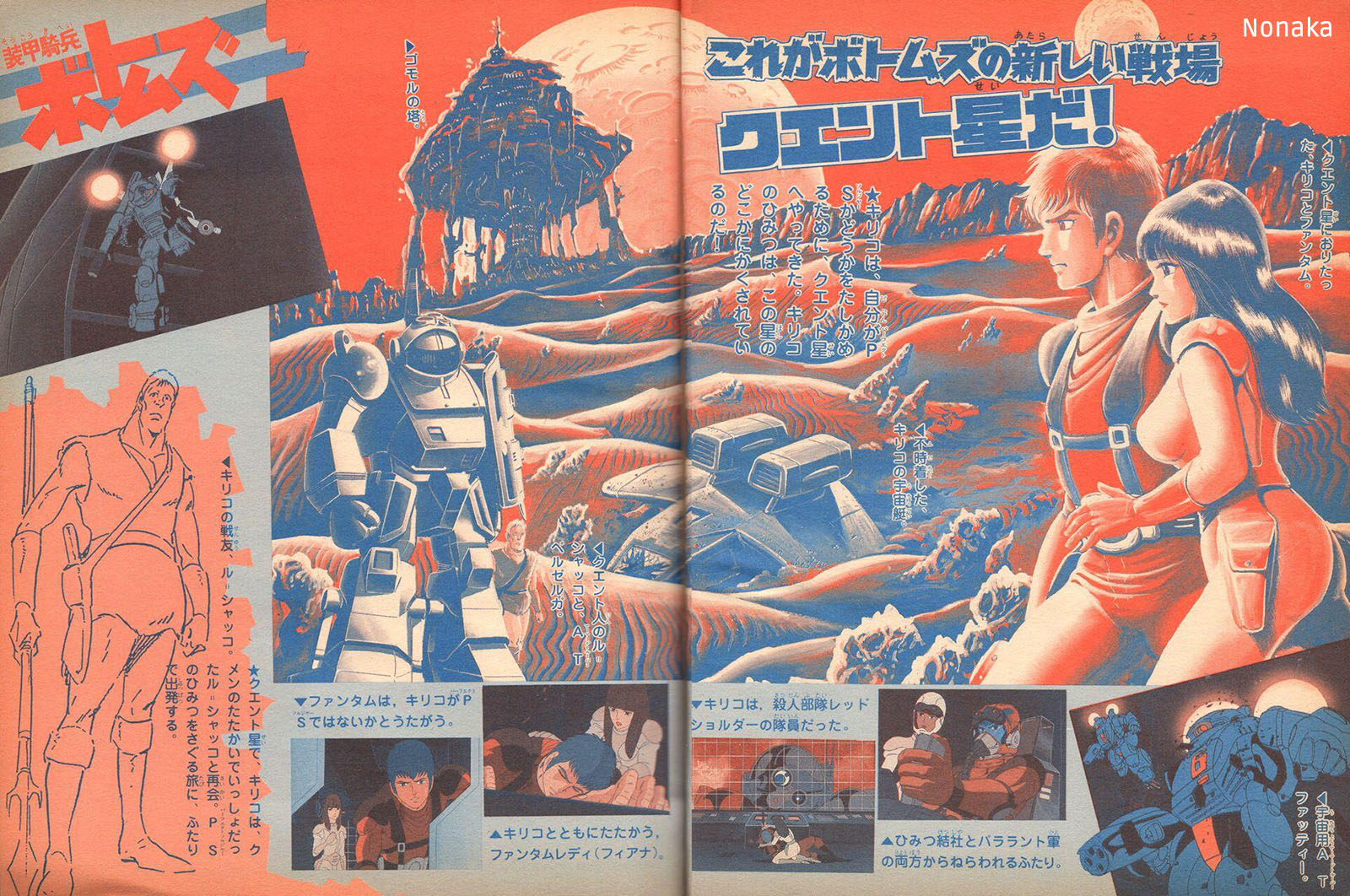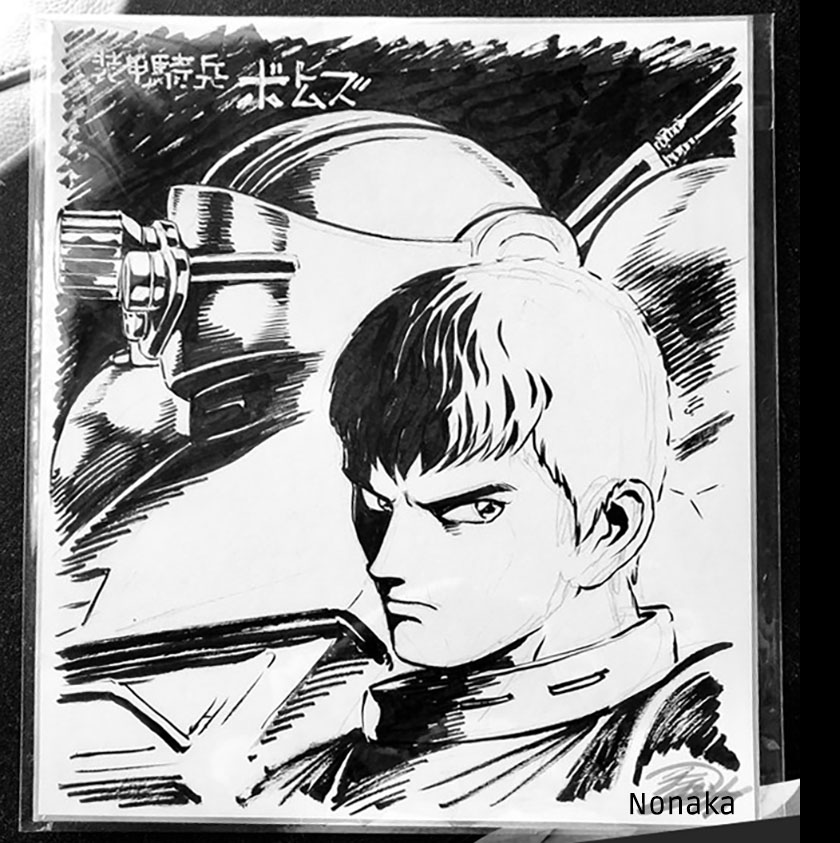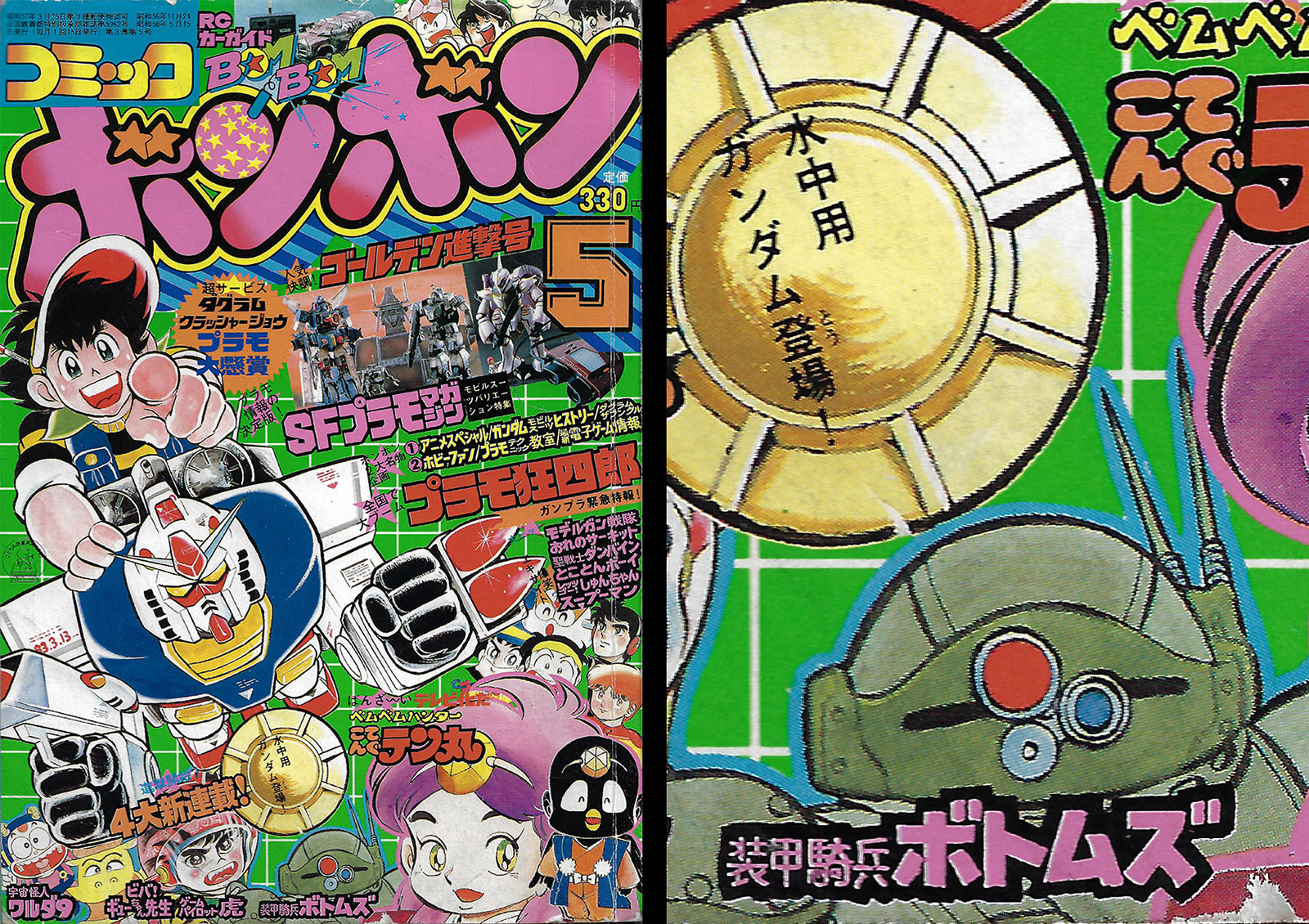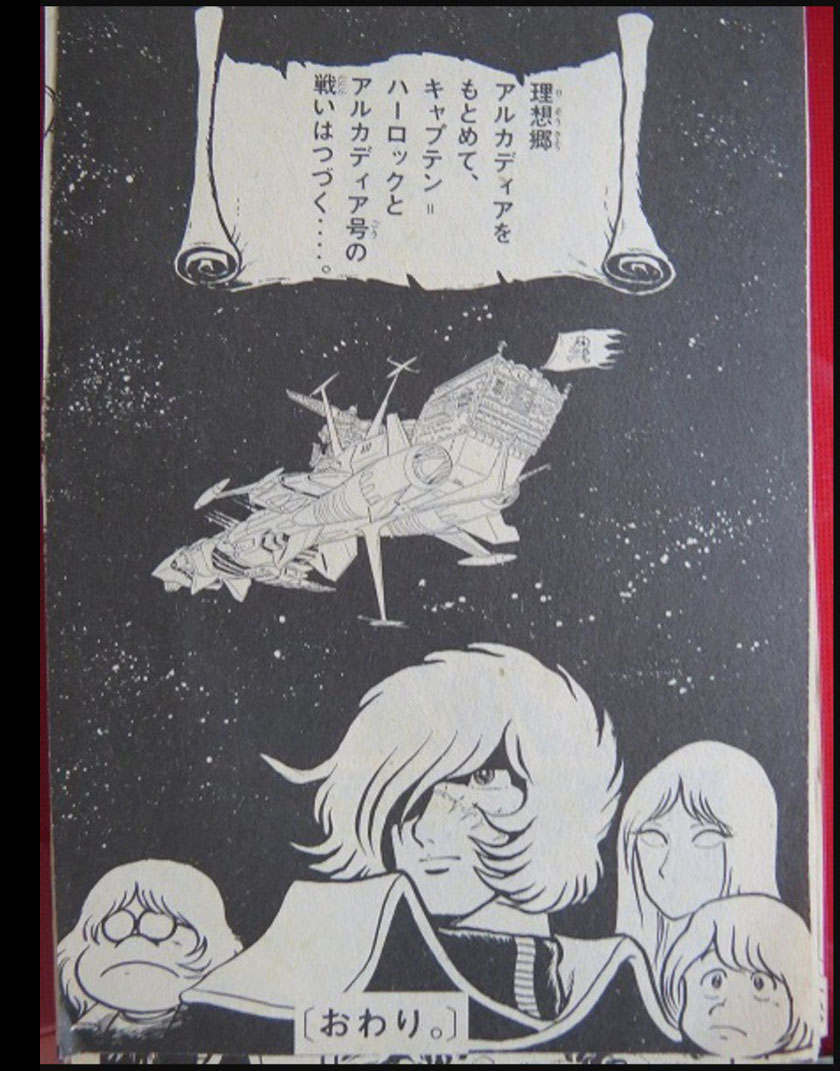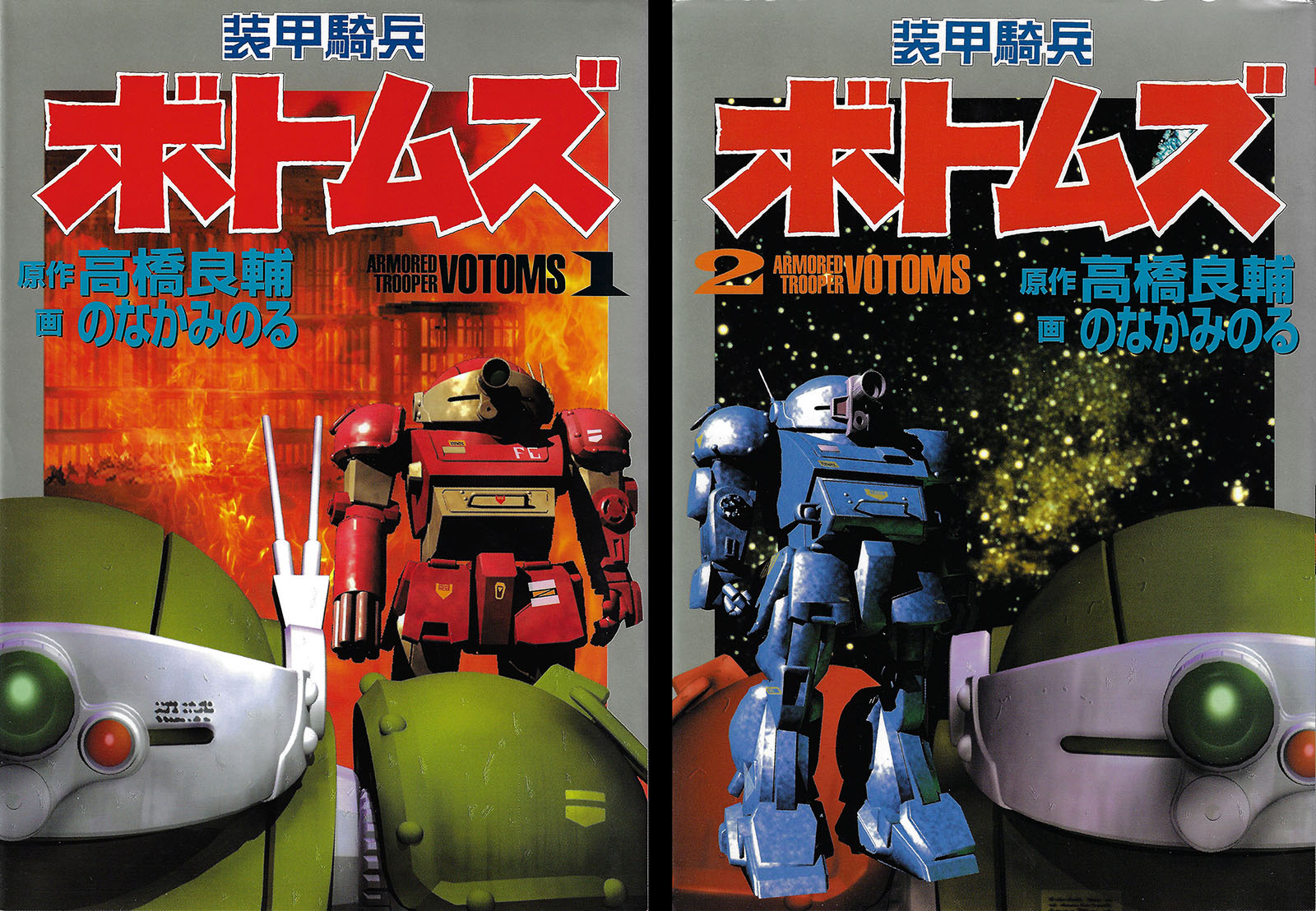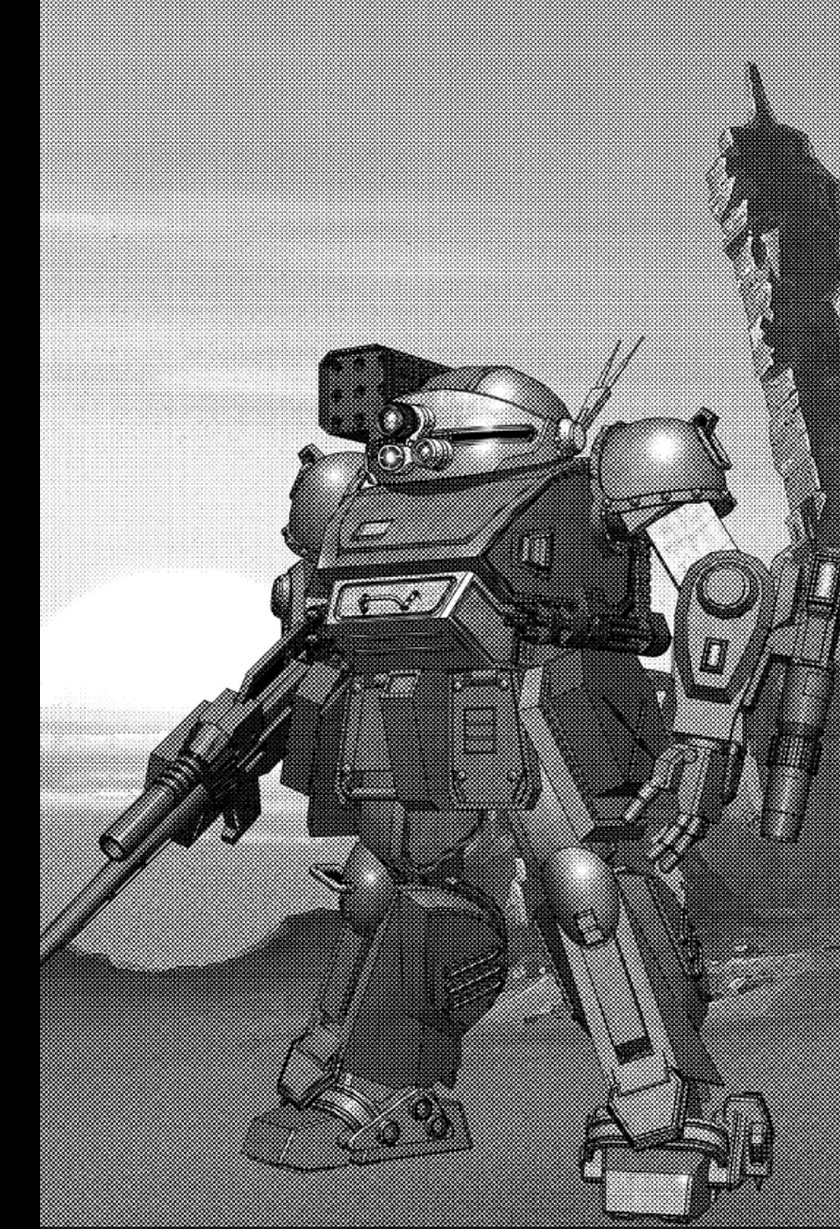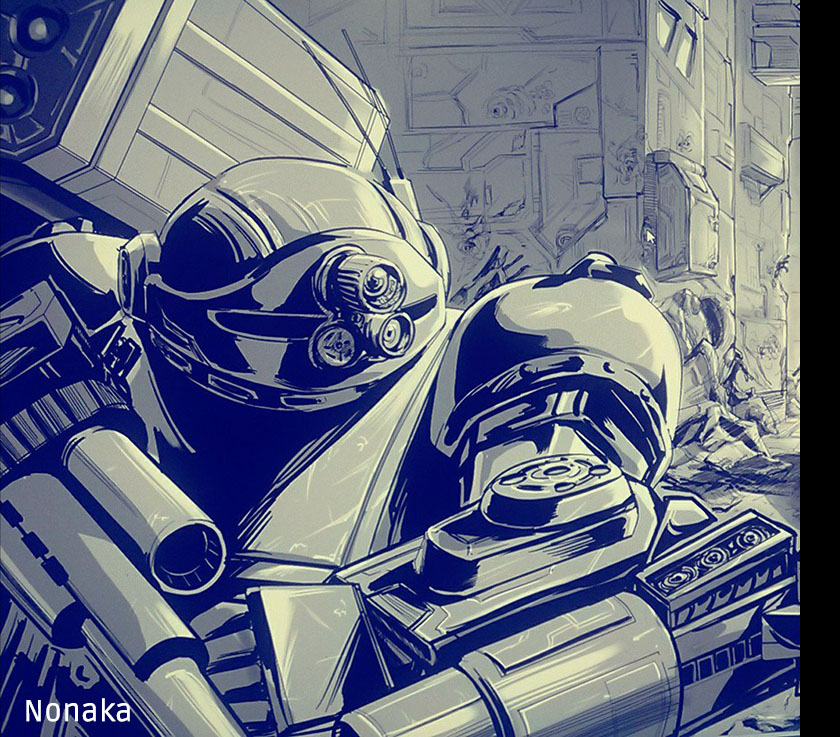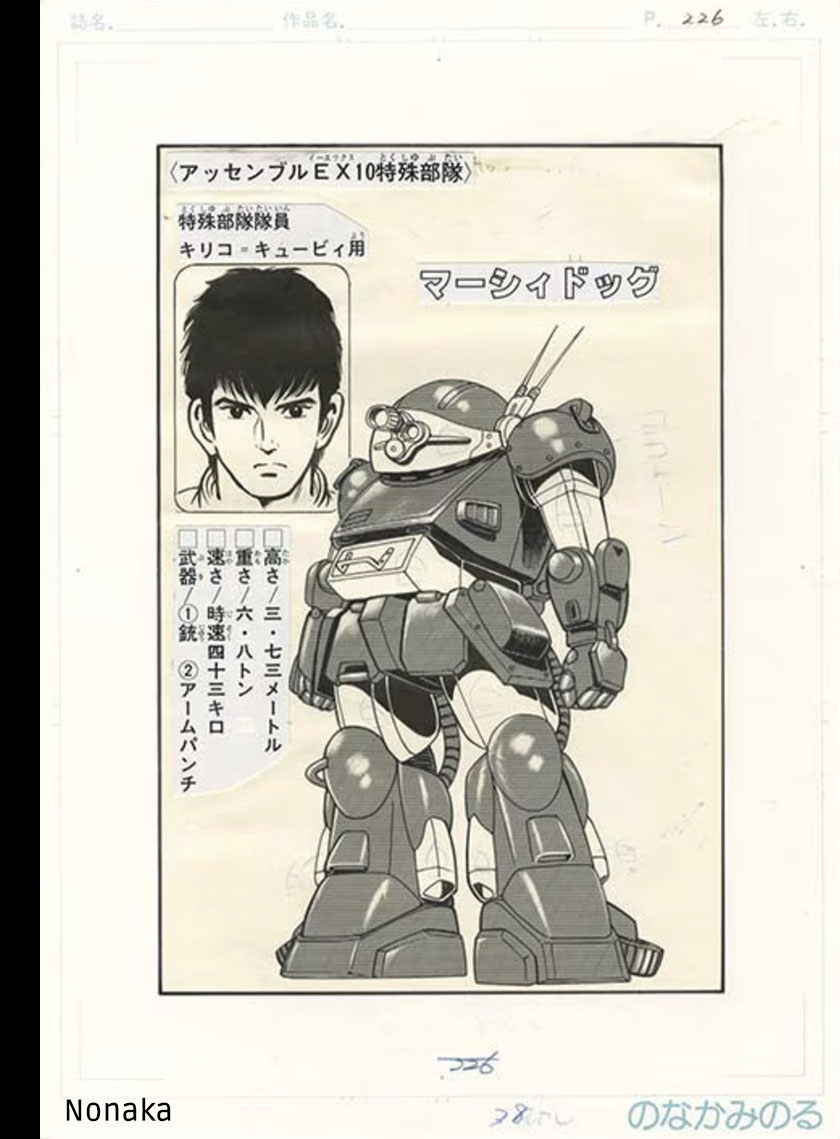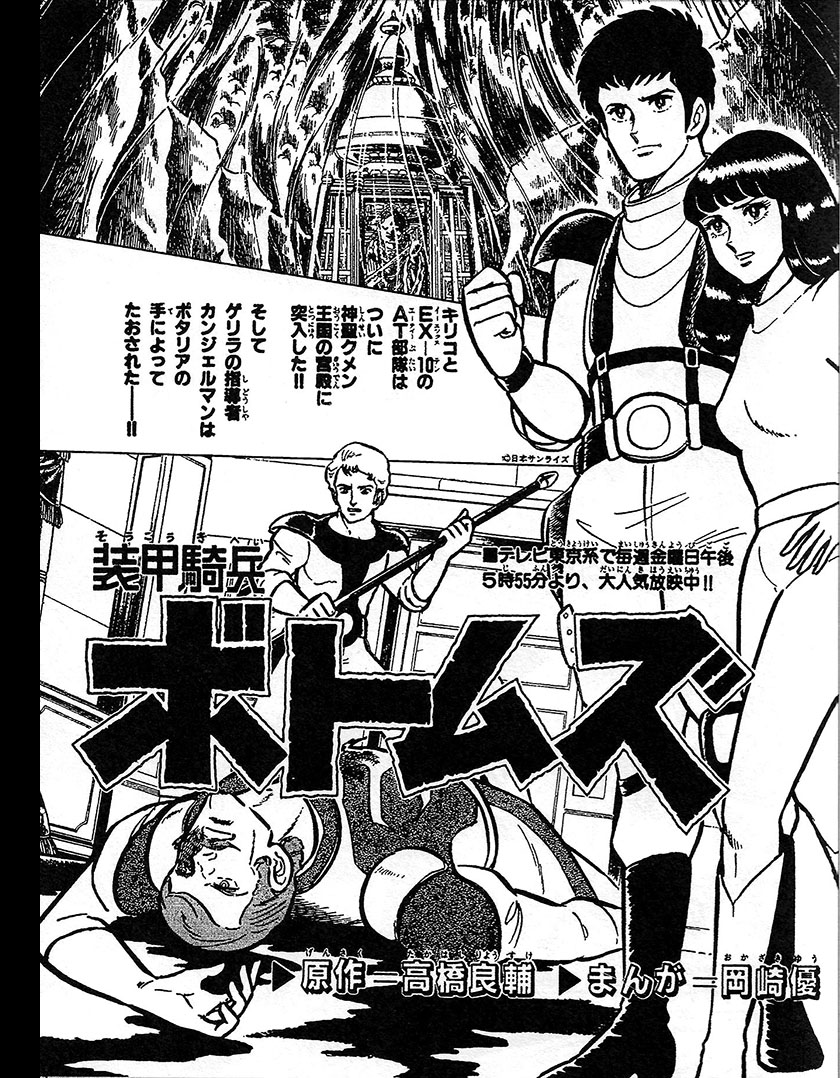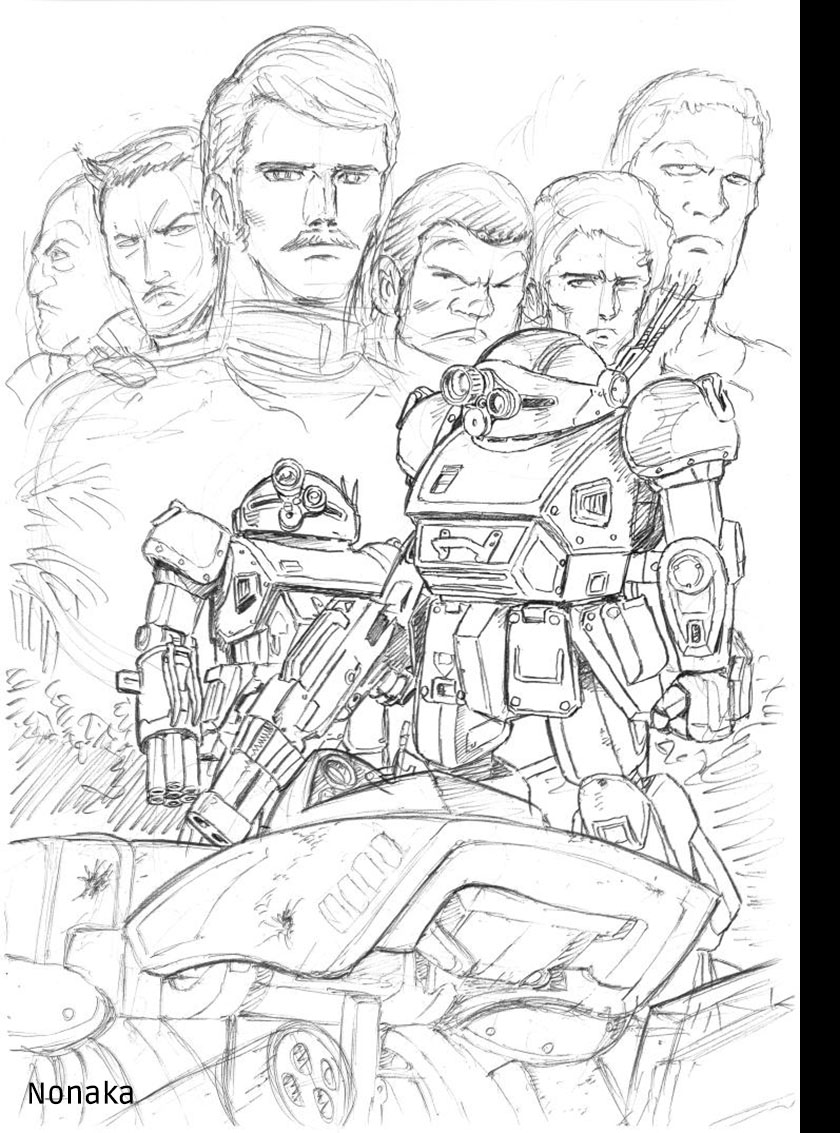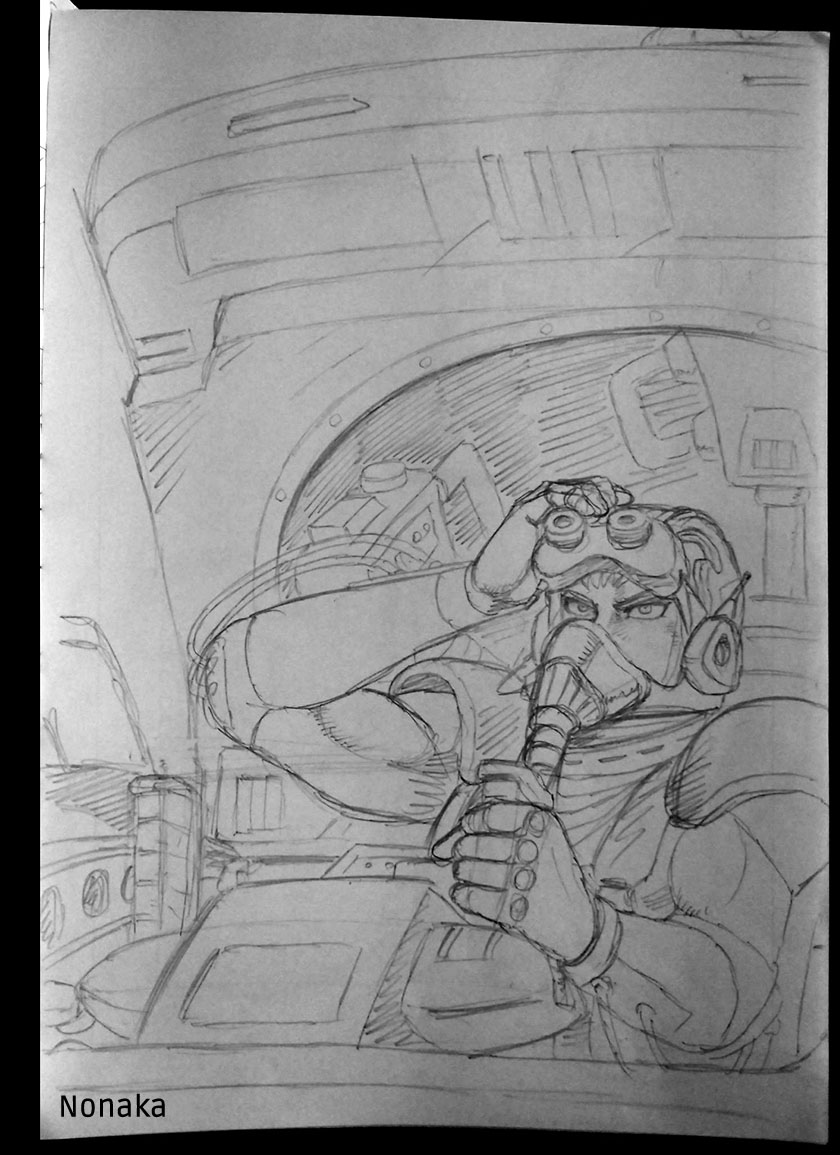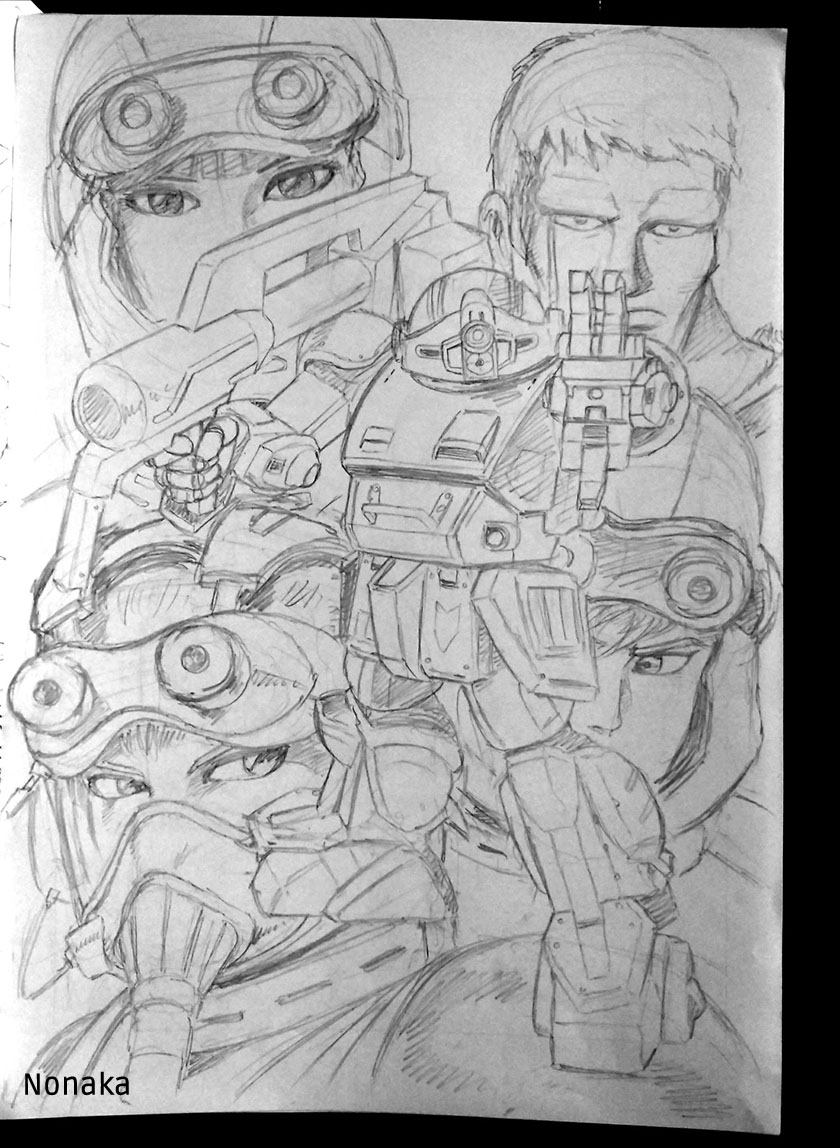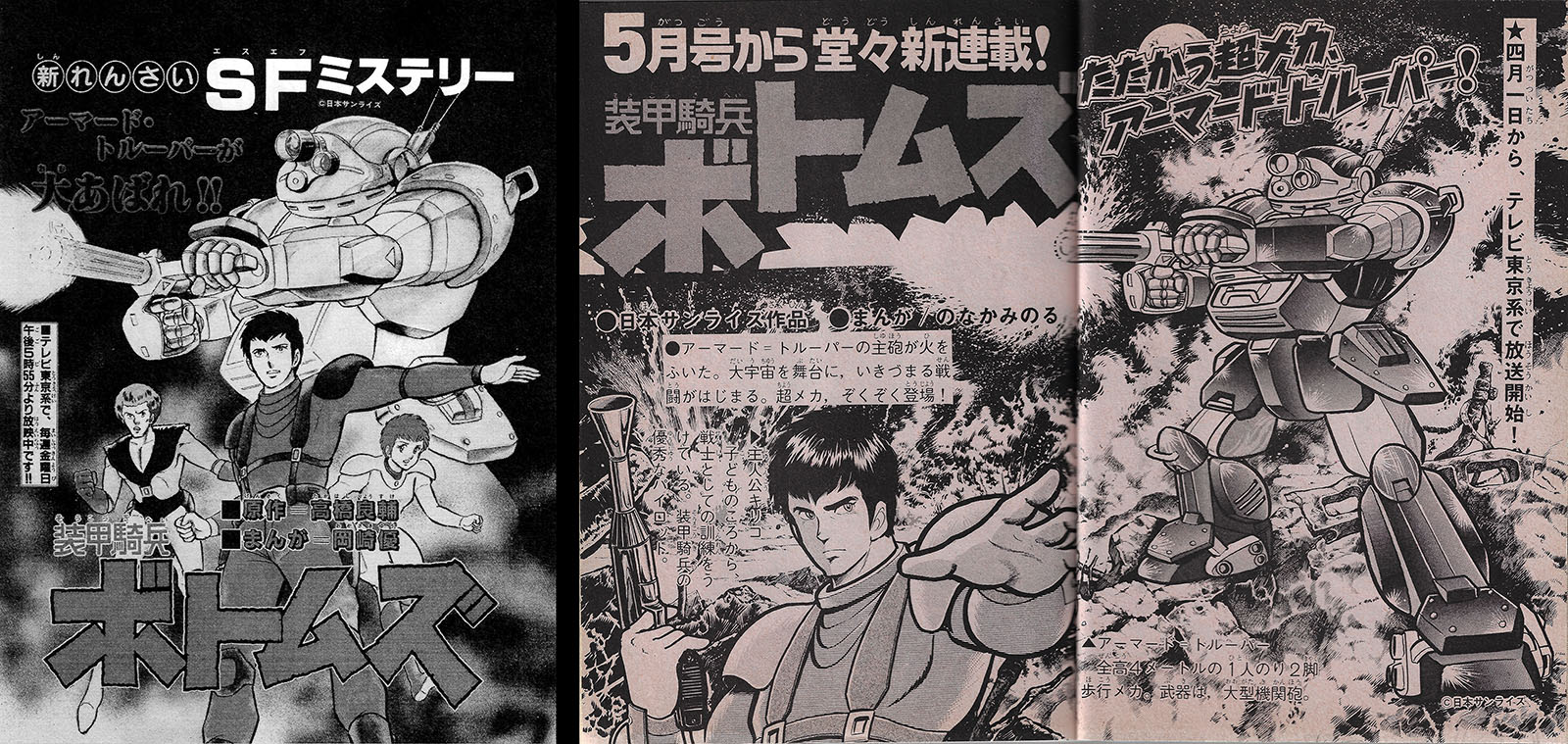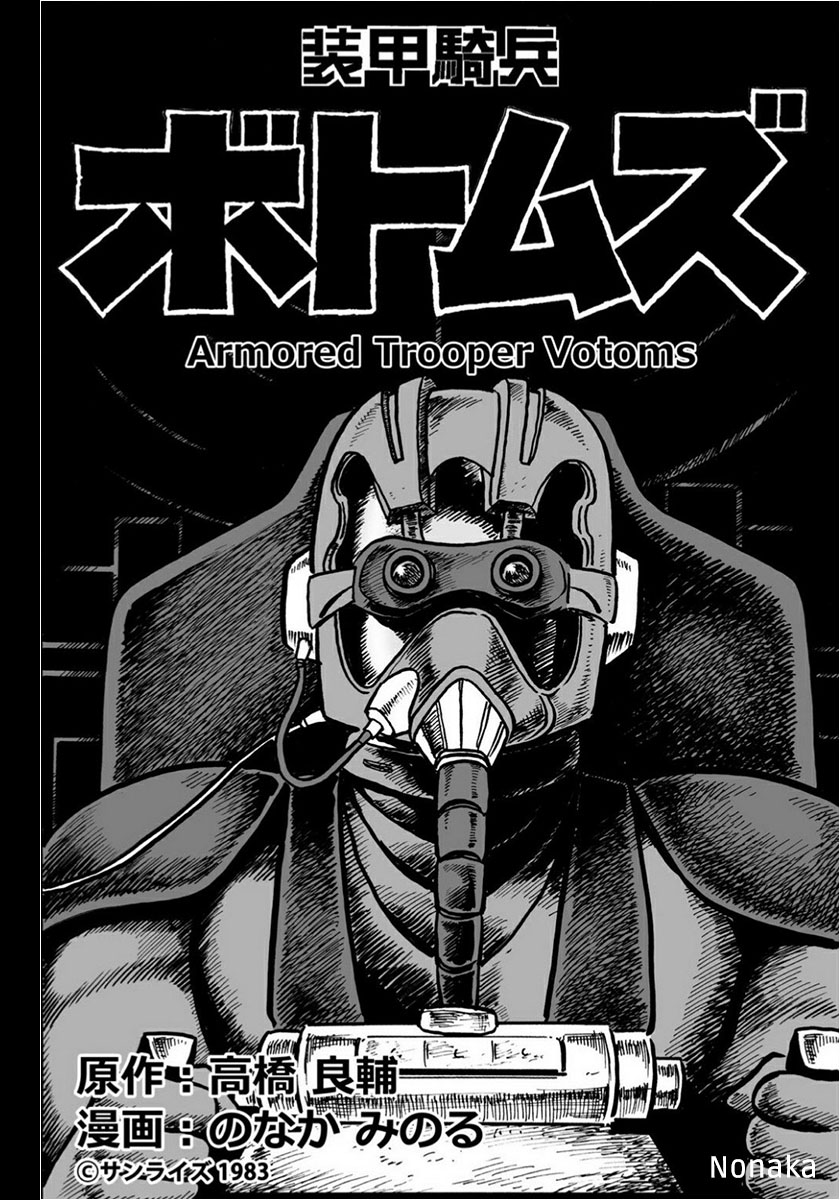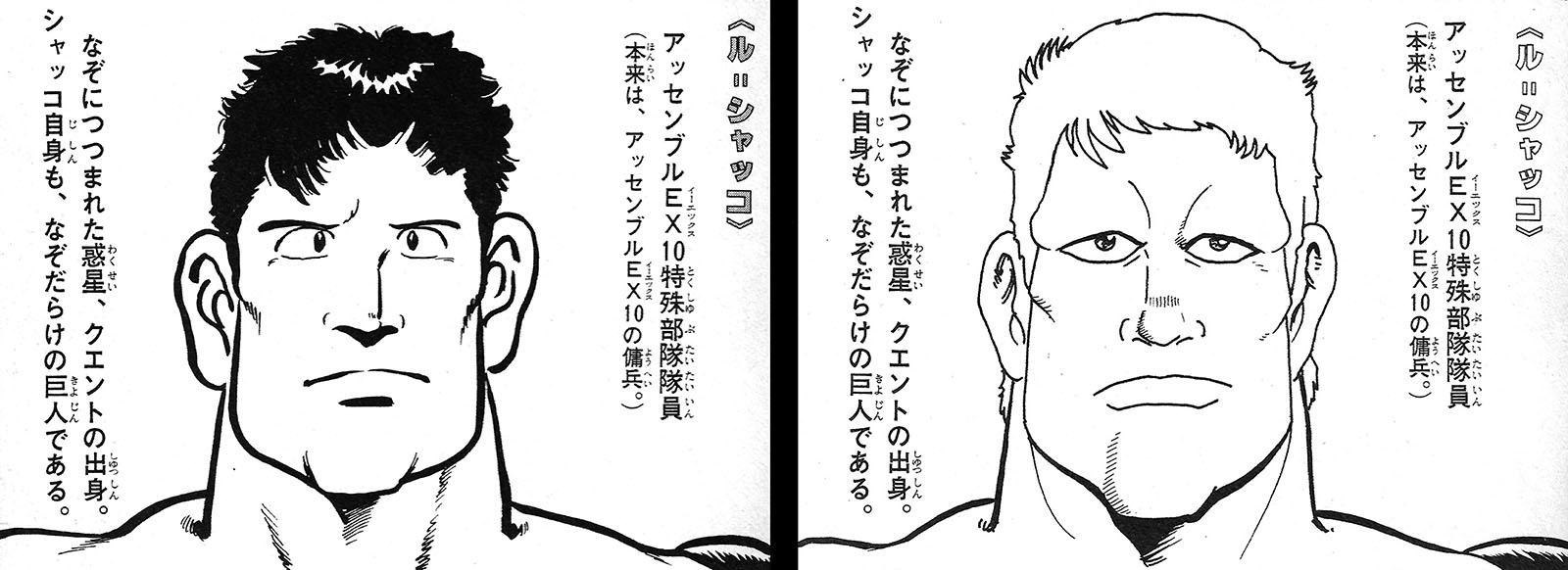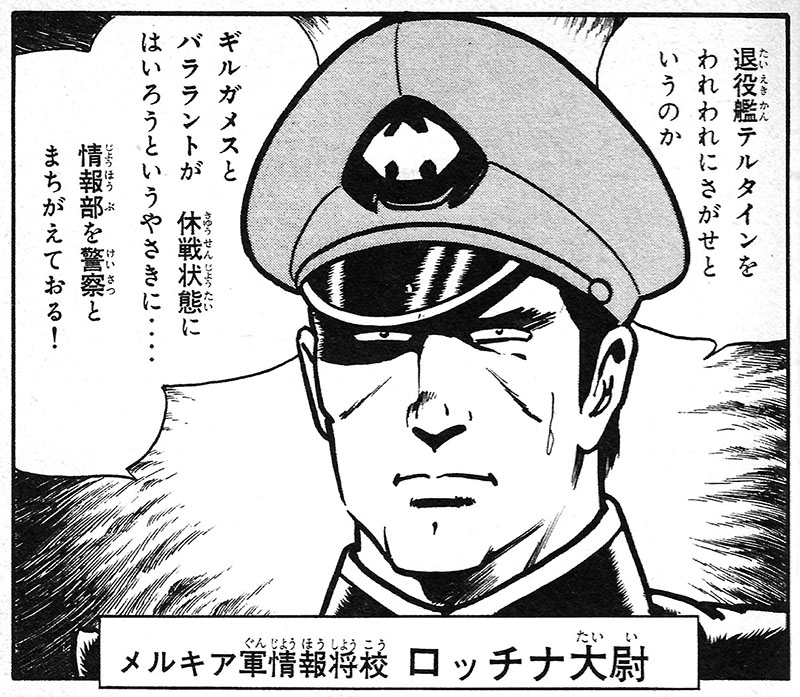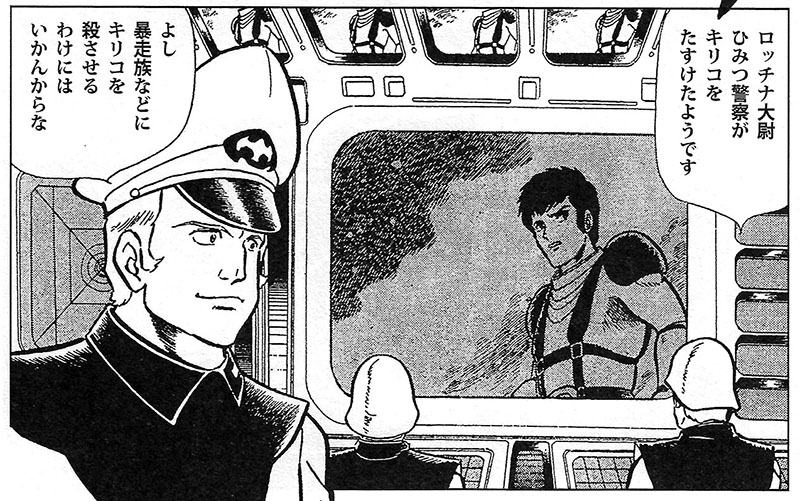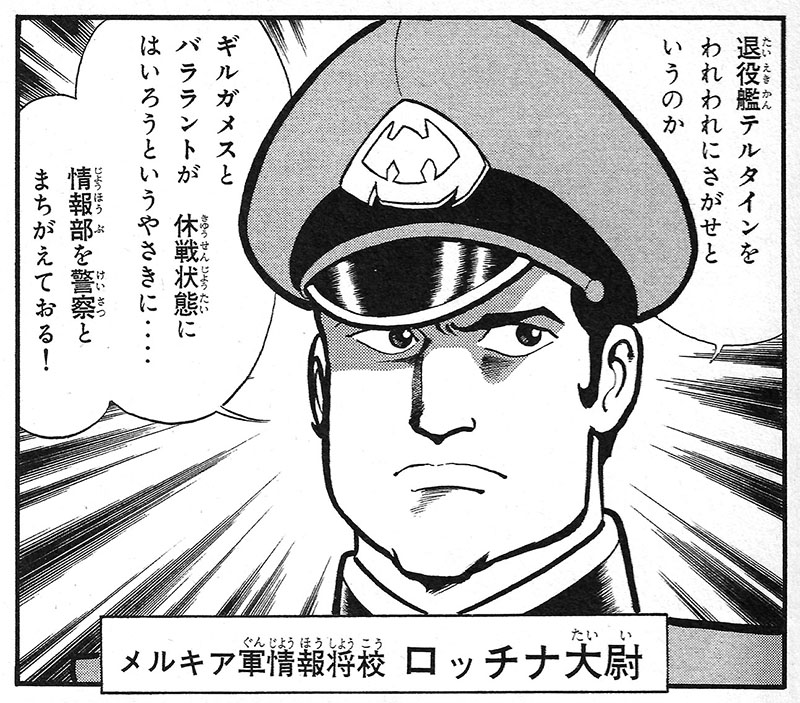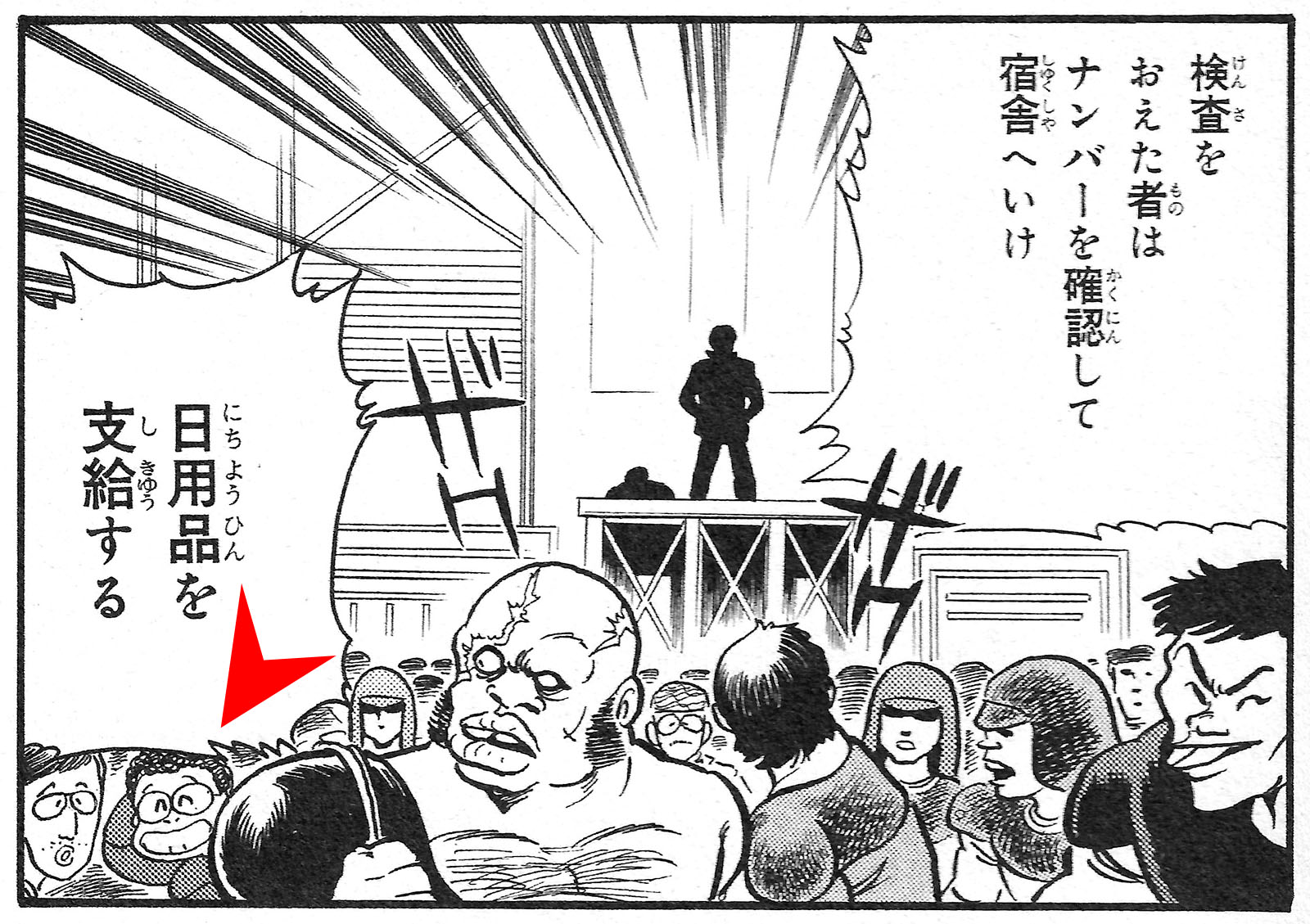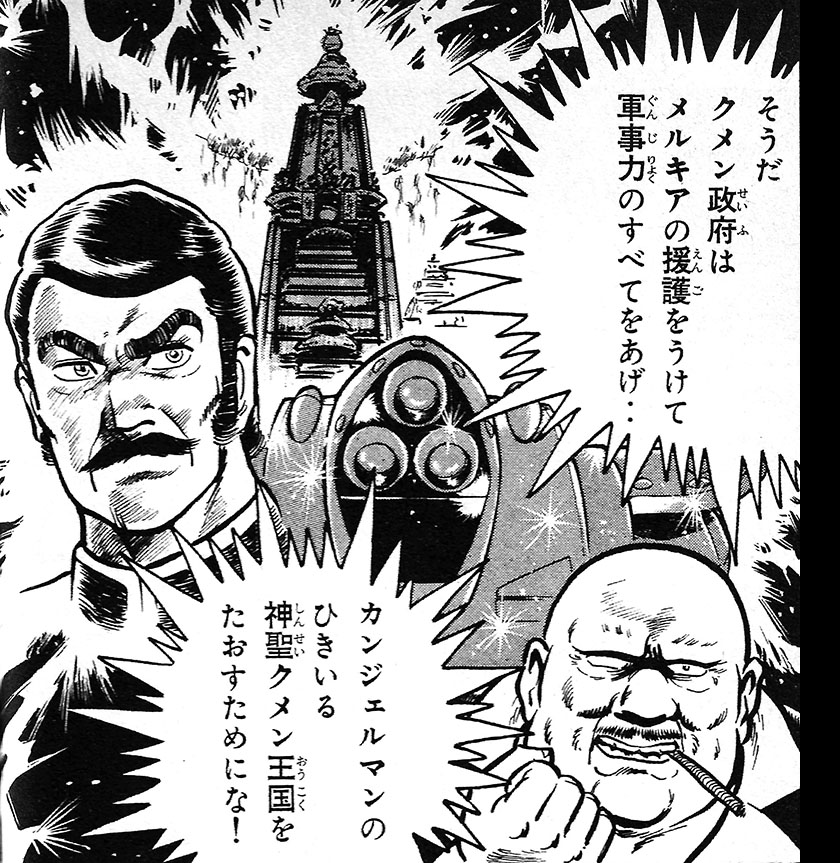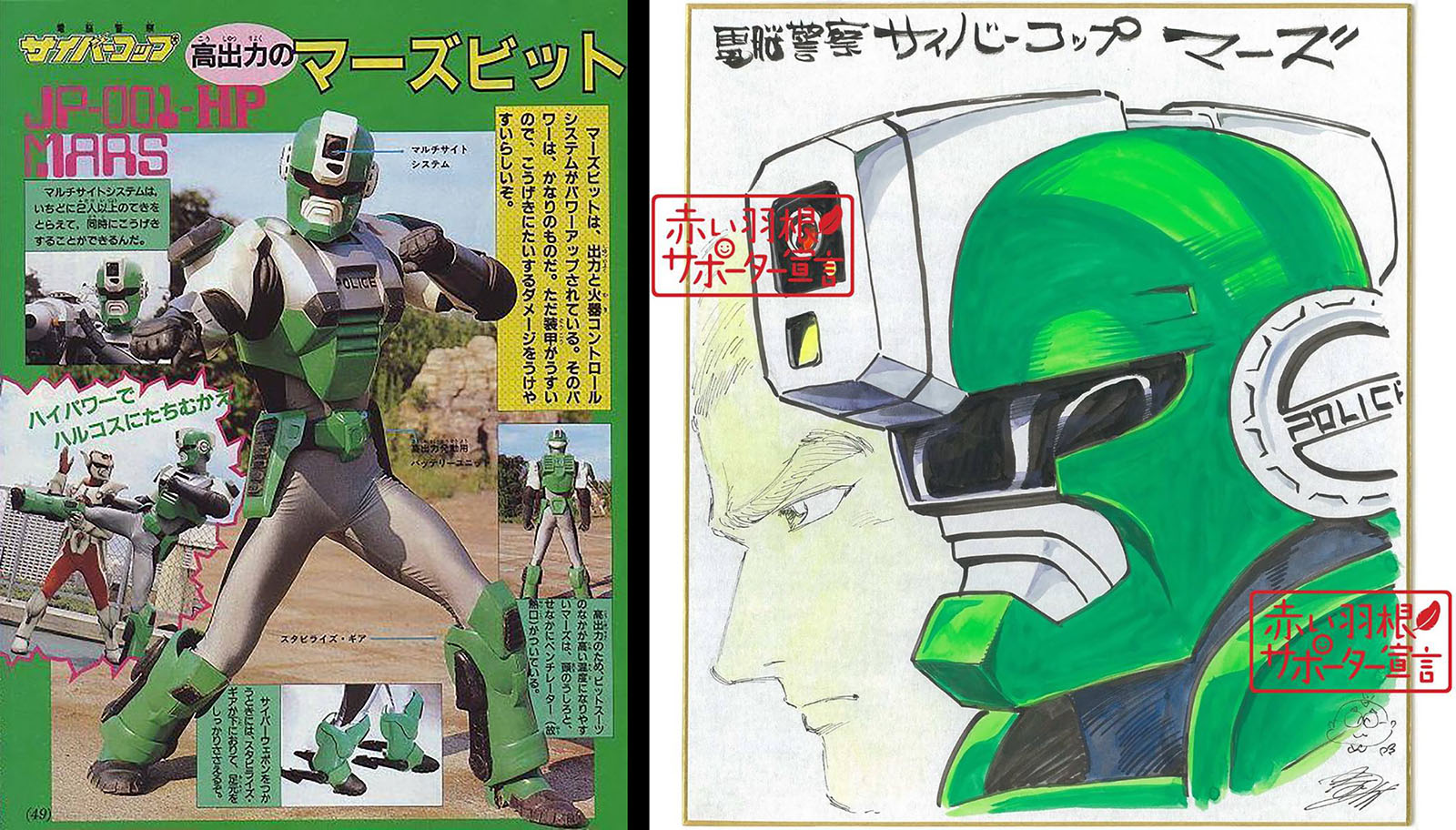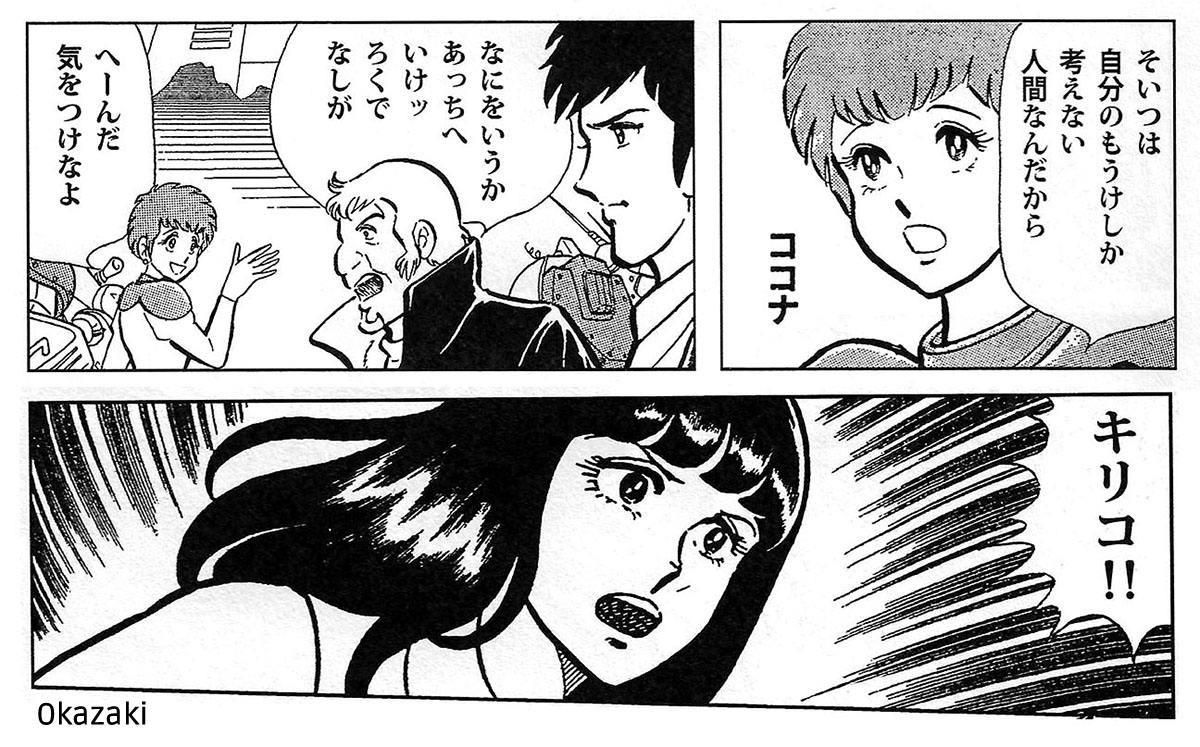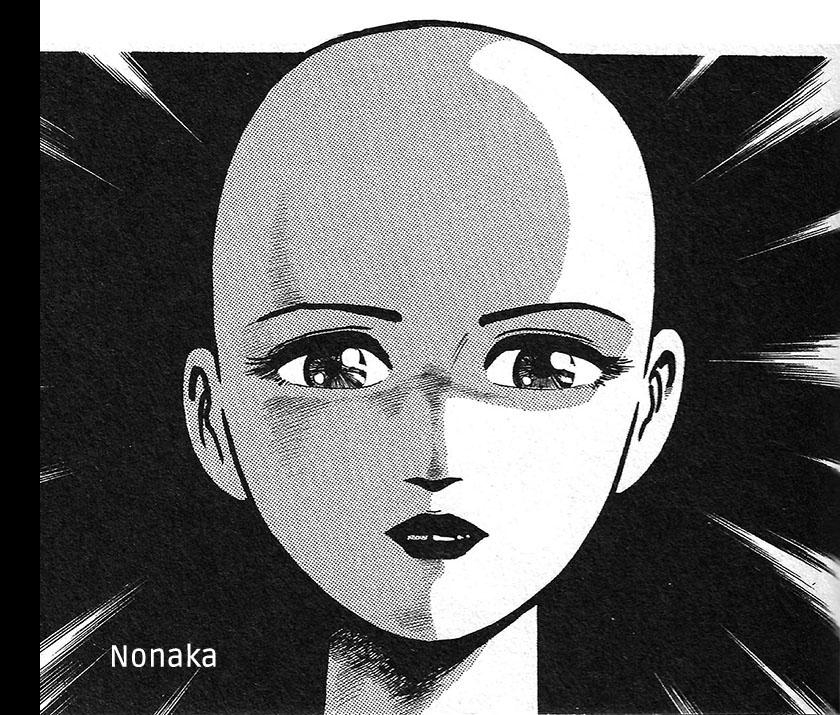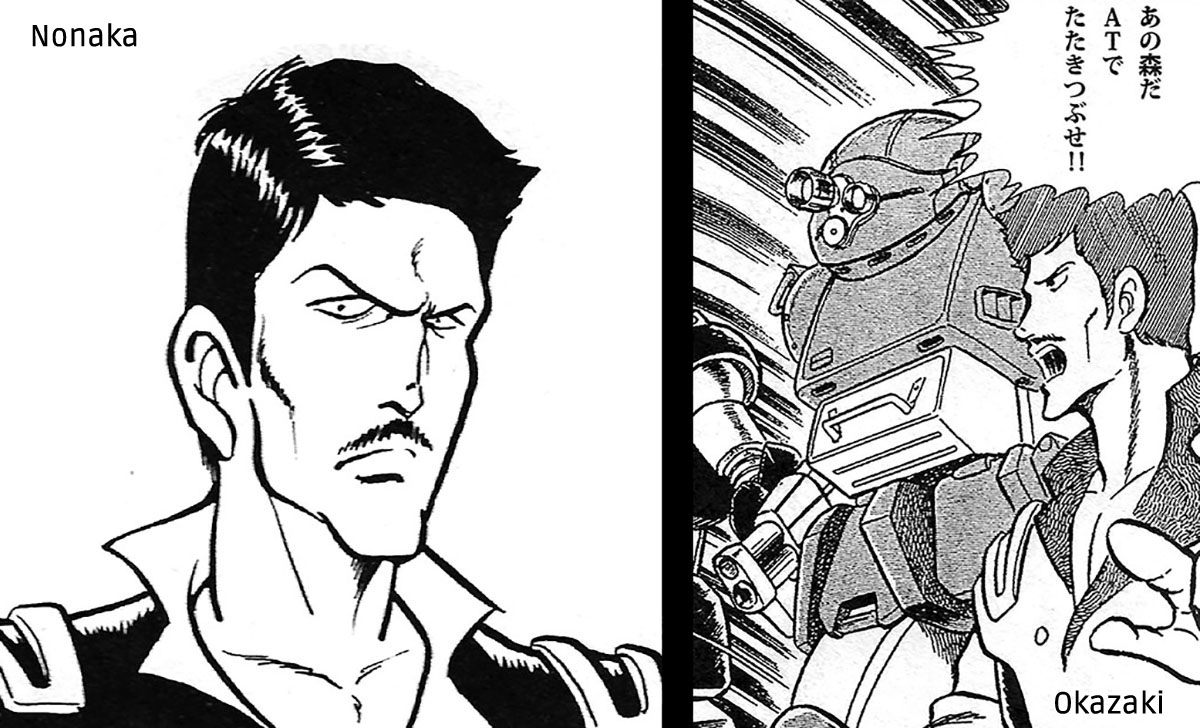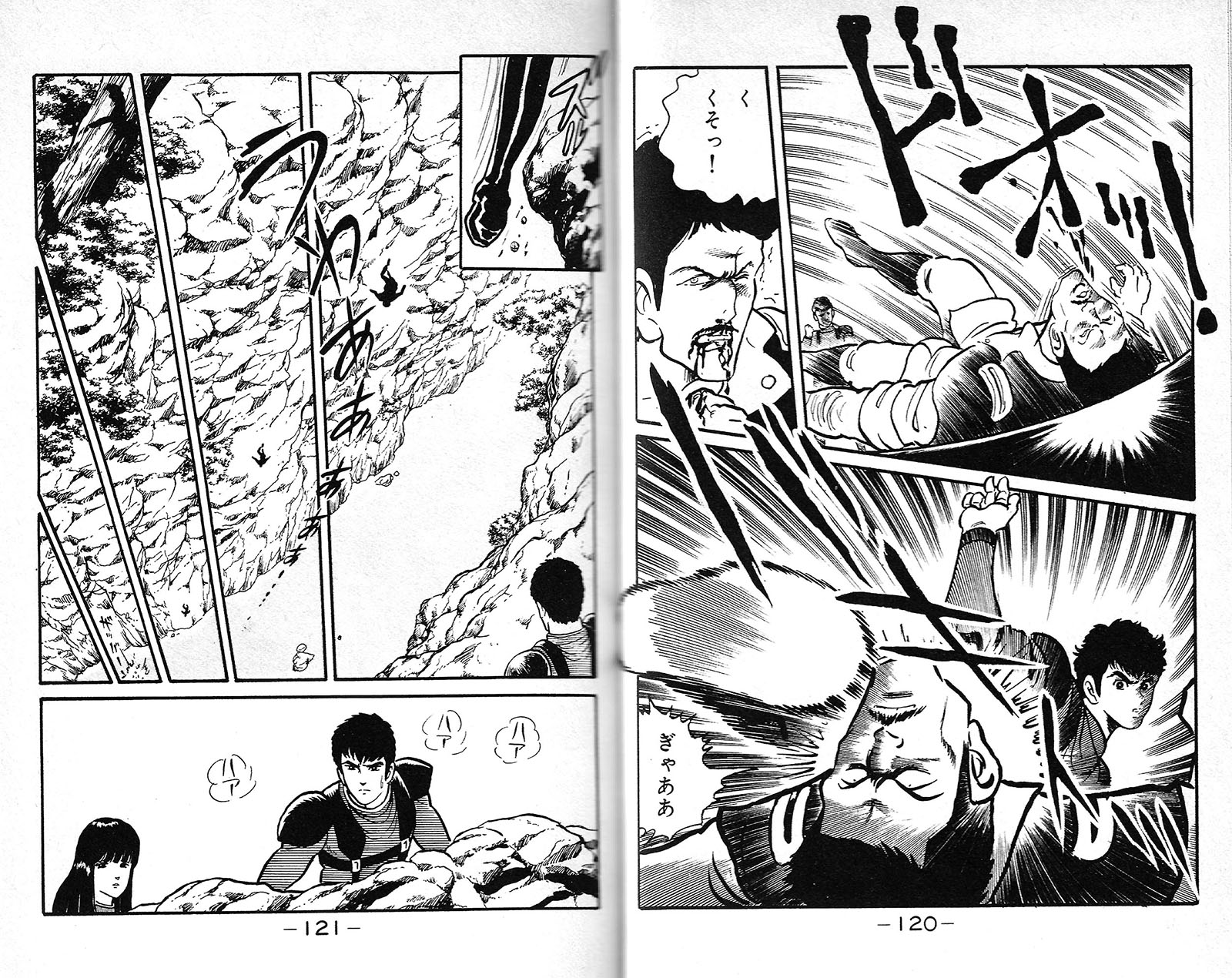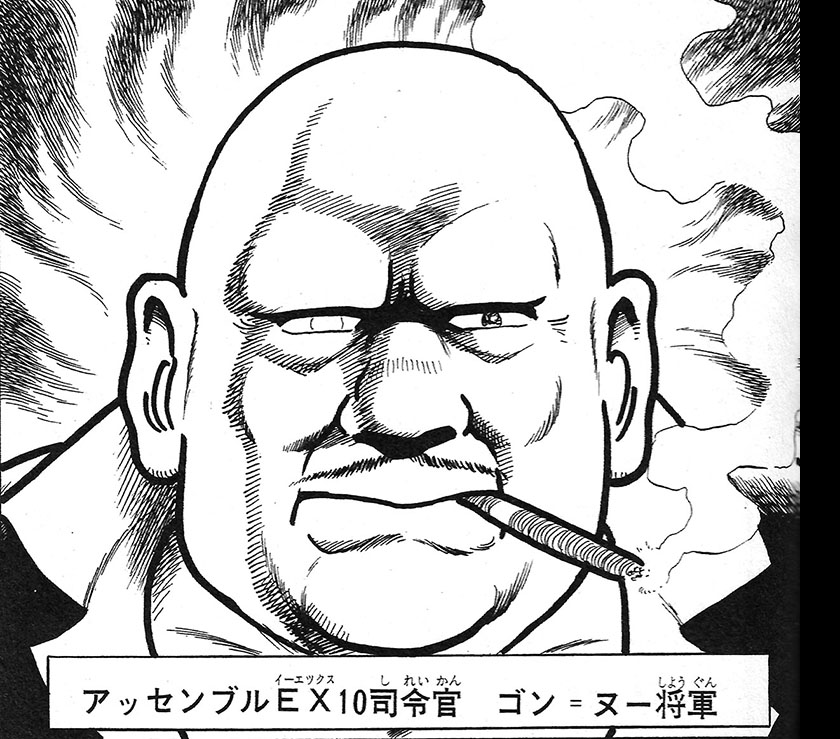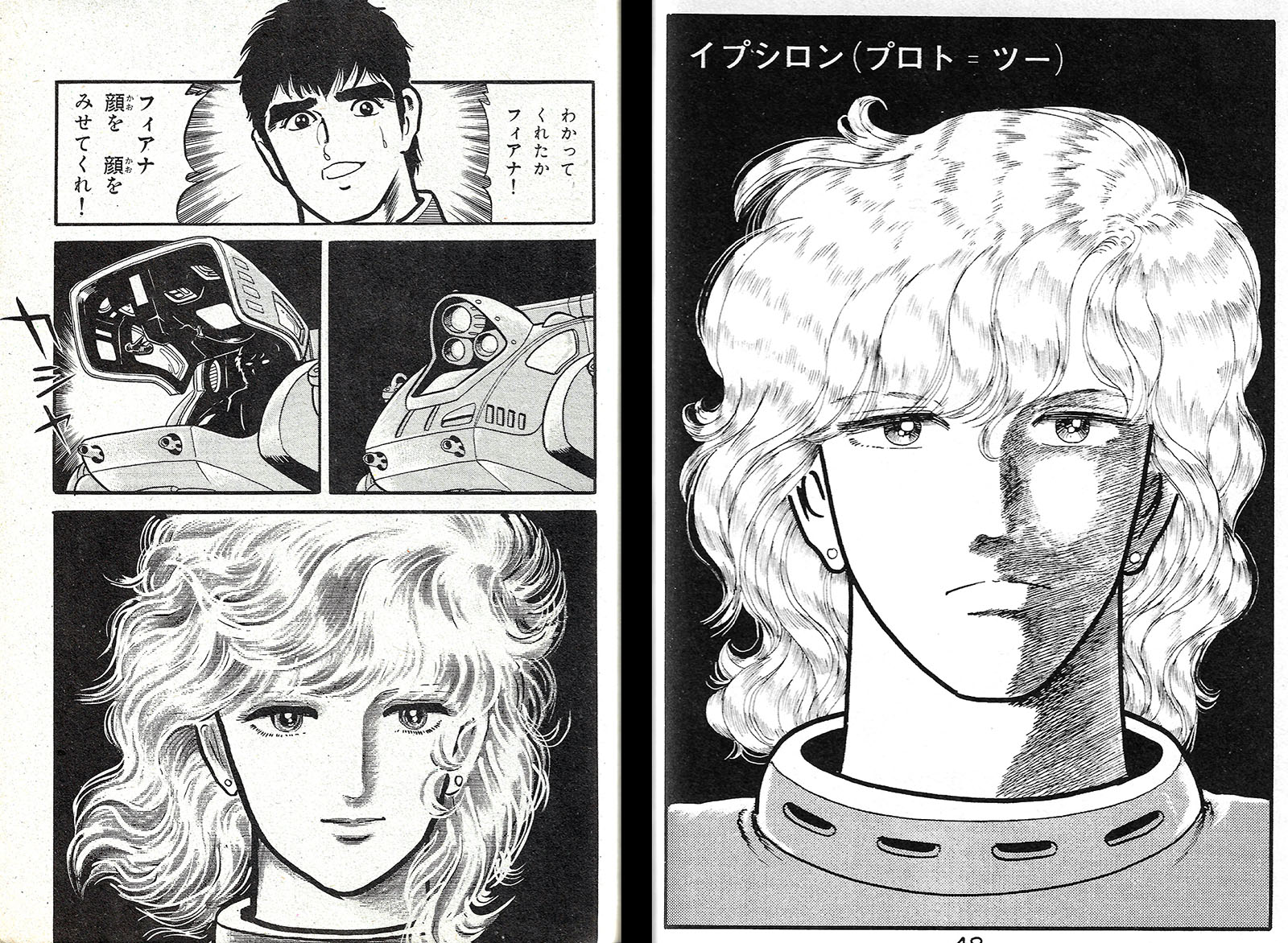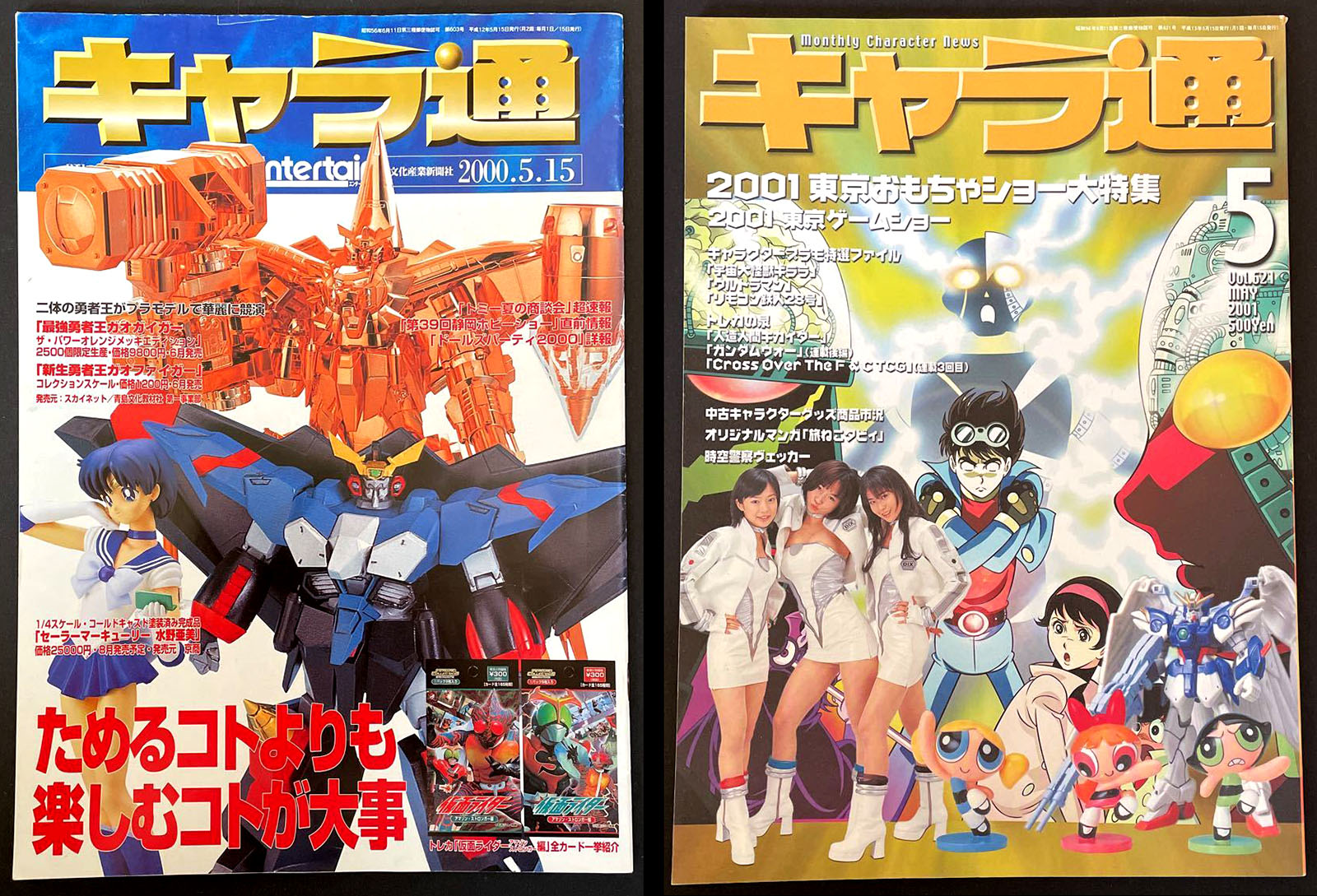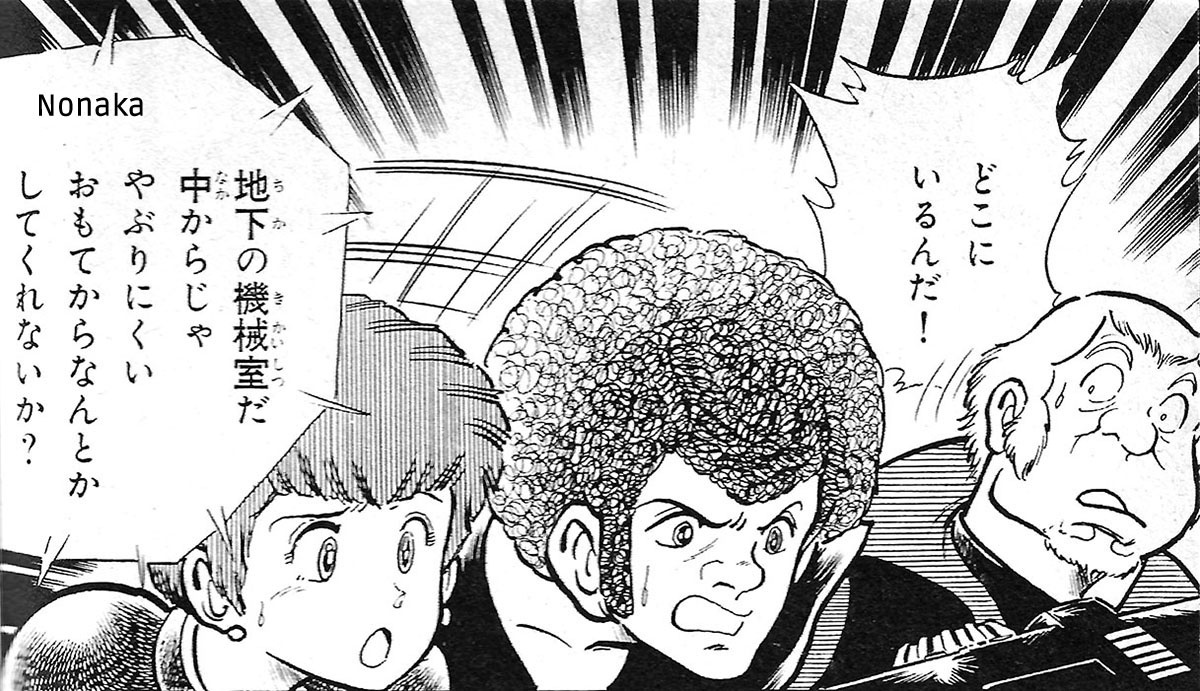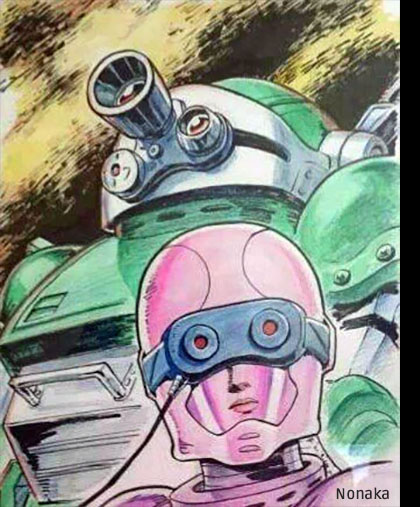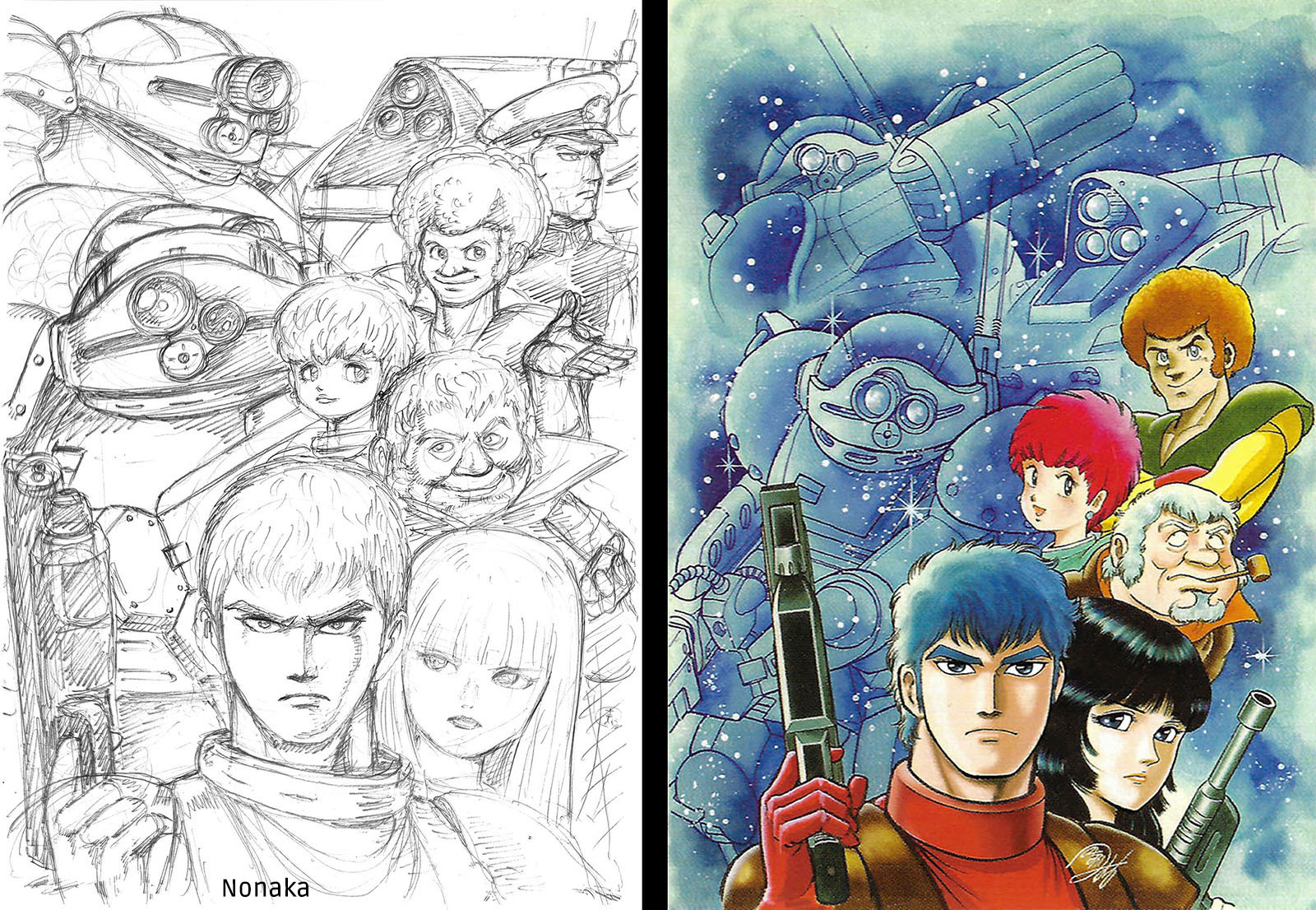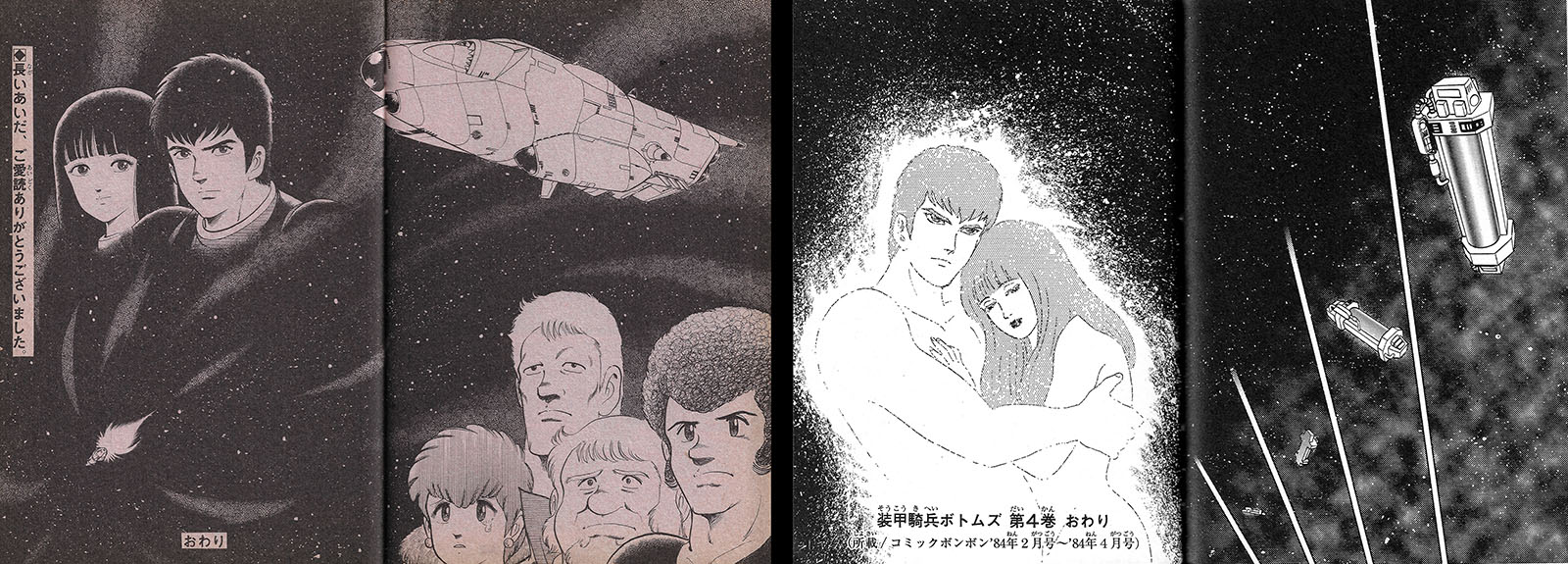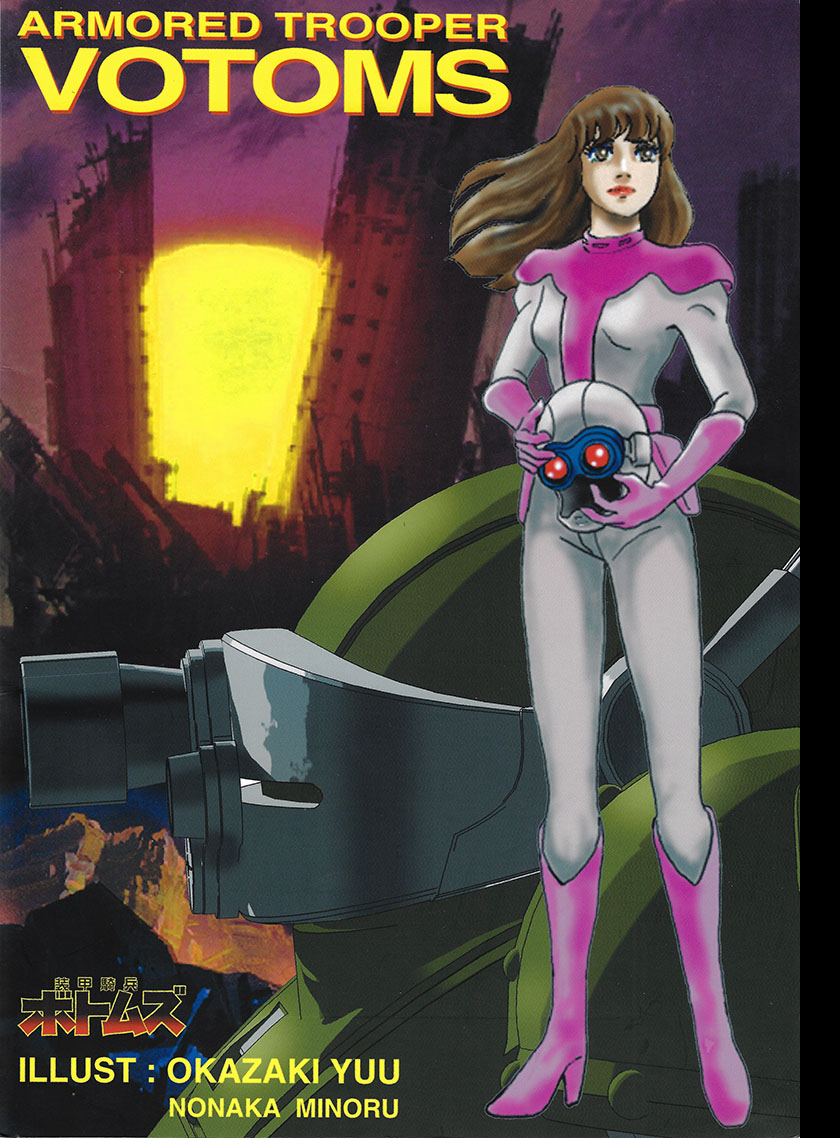Manga artist interview, 2001
Want to have some fun? Map out the various ways Votoms fandom sticks pins into Gundam fandom. Here’s an example: from 1998 to 2000, a series of nine Gundam tribute magazines was published by ASCII. The project marked the 20th anniversary of the show, so they went with the title G20. The second issue (from November ’98) is shown below left.
In the summer of 2001, a trio of mischievous young Votoms fans banded together under the name “Soudai Assemble EX-10” and published their own parody fanzine titled V20. Their favorite character was the mercurial love-to-hate-him Kummen commander Kan Yu, so they made him the “star.” This 66-page ‘zine presented all sorts of Votoms eclectica, including a truly one-of-a-kind interview.
It is generally well understood that the Votoms manga adaptation was serialized by Minoru Nonaka for Kodansha’s Comic BomBom magazine and then expanded for subsequent paperback editions. (If you didn’t know that, just look a little deeper into this website.) What is NOT generally well understood is that a second Votoms manga was being published at exactly the same time by a different publisher. This one ran in Akita Shoten’s short-lived TV Anime Magazine, drawn by accomplished manga legend Yu Okazaki. (It was finally reprinted ten years after V20 appeared, and can be seen here.)
In the process of creating V20, the lads of “Soudai Assemble EX-10” did what no one else ever accomplished: brought both Votoms manga artists together for a double interview. Not only did they know each other, they worked for the legendary Go Nagai at the same time. And here’s what they had to say about it…
V20 special project: Interview with Votoms manga creators!
Yu Okazaki & Minoru Nonaka
Conducted by Assemble EX-10: Black Endo, Hiroshi Paru, and Shimoji Rin
How did Yu Okazaki and Minoru Nonaka’s miraculous double interview come about? In winter 2000, about a month before Soudai Assemble was organized, we decided to make a Kan Yu book out of our joke madness. When the book was released, a website called Kan Yu net was posted on the internet to promote our insatiable obsession with Kan Yu.
Then the incident occurred. When Minoru Nonaka saw an article we posted titled “Verification! Manga version of Votoms” he wrote “An apology to Votoms fans” on the bulletin board.
With that as a starting point, we arranged an interview on a certain day in May 2001, with a face-to-face meeting before the interview. Unfortunately, the revelatory conversation with Mr. Nonaka that took place there is off the record. It was a series of startling facts that would have scandalized the industry if it was leaked to the public. We knew from prior research that Mr. Nonaka’s senior at Dynamic Pro, Yu Okazaki, was also involved in the comicalization of Votoms. Mr. Nonaka promised to contact Mr. Okazaki himself. Miracle after miracle.
Finally, on June 16, an interview with the two Votoms manga artists took place. It is a miracle that we were able to do this. Such a project would be difficult to realize even in a commercial magazine. The dream of the Votoms world by two of Dynamic Pro’s stars is now in full swing, and we are excited to see what they have in store for us in the 21st century.
Now, Armored Troopers deploy for the parallel world of the master cartoonists of Votoms in the 21st century!
[Translator’s notes: (1) Dynamic Pro is the studio of anime/manga legend Go Nagai, creator of Mazinger Z, Devilman and many other classics. Both of these gentlemen worked there in their early years. (2) “Comicalize” is the Japanese term for a manga adaptation of a TV show or film.]
PROFILES
Yu Okazaki
Born on August 28, 1951 in Mie Prefecture. Manga artist. His representative works are the manga versions of Mobile Suit Gundam, Grendaizer, Armored TrooperVotoms (published in TV Anime Magazine), Nightmare Visitor, and many others.
Minoru Nonaka
Born on September 8, 1957 in Iwate Prefecture. Manga artist. His representative works are Votoms ( Comic BomBom magazine, Space Sherrif Gavan, Radio Control Kid, Cyber Cop, Bone Bone, Tokyo Yurei Map, and many others. Visit his website here and Twitter page here.
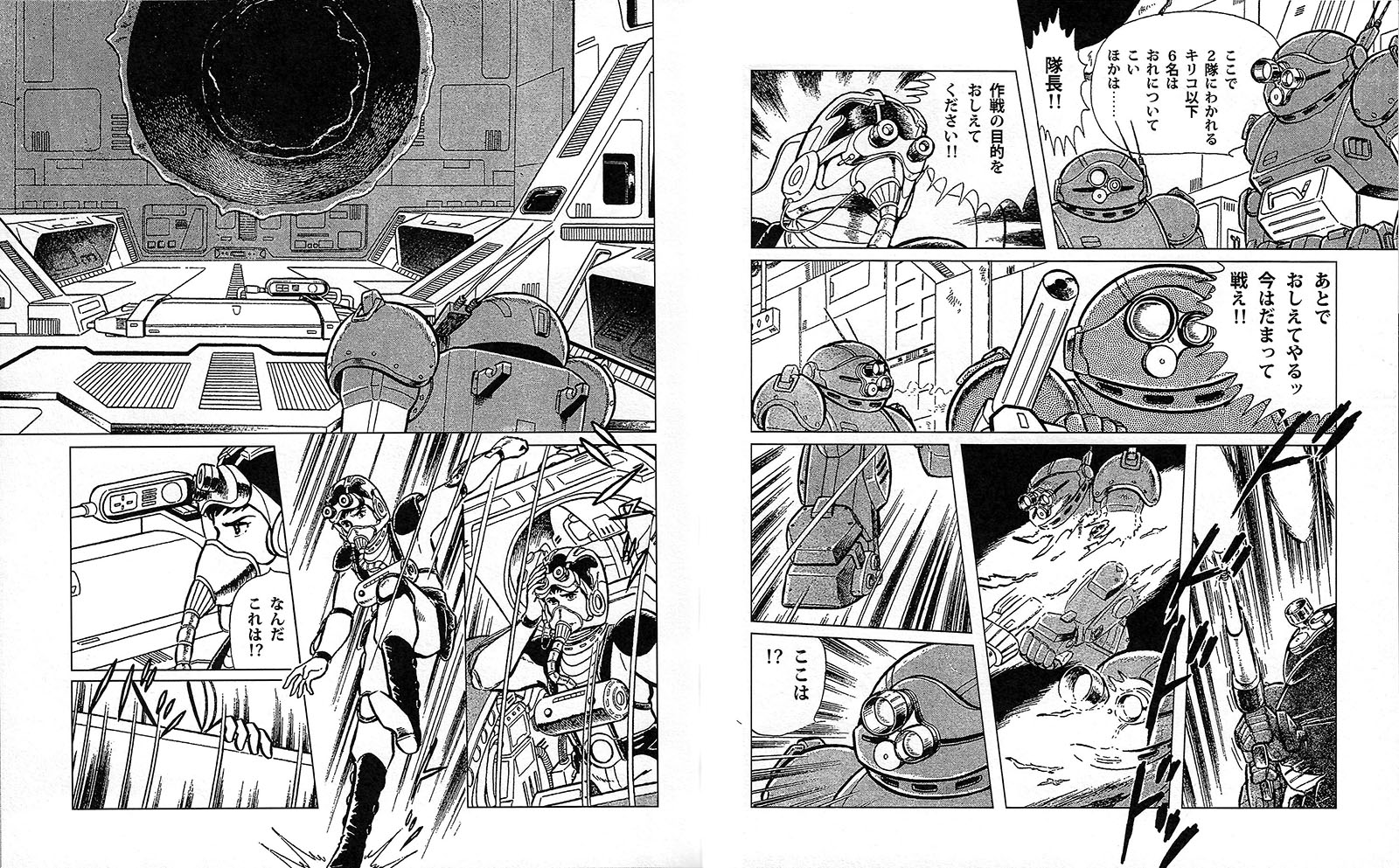
Yu Okazaki’s version of Votoms
Nonaka: Wasn’t this [manga series] somewhat of a pillar? I don’t know if it was cut short or not.
Paru: Wasn’t it in Terebi Magazine?
Nonaka: It was TV Anime Magazine, a spinoff of Bouken Oh [Adventure King].
Okazaki: Only for a short time. (Laughs) The magazine didn’t last long.
Nonaka: It was over really quickly…or rather, it was brought to an end.
Paru: Was the whole Votoms project terminated in the middle?
Okazaki: I’m not sure… I don’t remember anymore. (Laughs)
Nonaka: I was so surprised to see it when I was drawing Votoms for BomBom… and Okazaki-senpai was like, “Oh my God!”
Paru: “We’re drawing the same thing!” (Laughs)
Okazaki: The pages were totally different. I did only about 8 pages a month.
Paru: Oh, but this… (looks at Okazaki’s version of the first episode of Votoms)
Nonaka: Good quality, right?
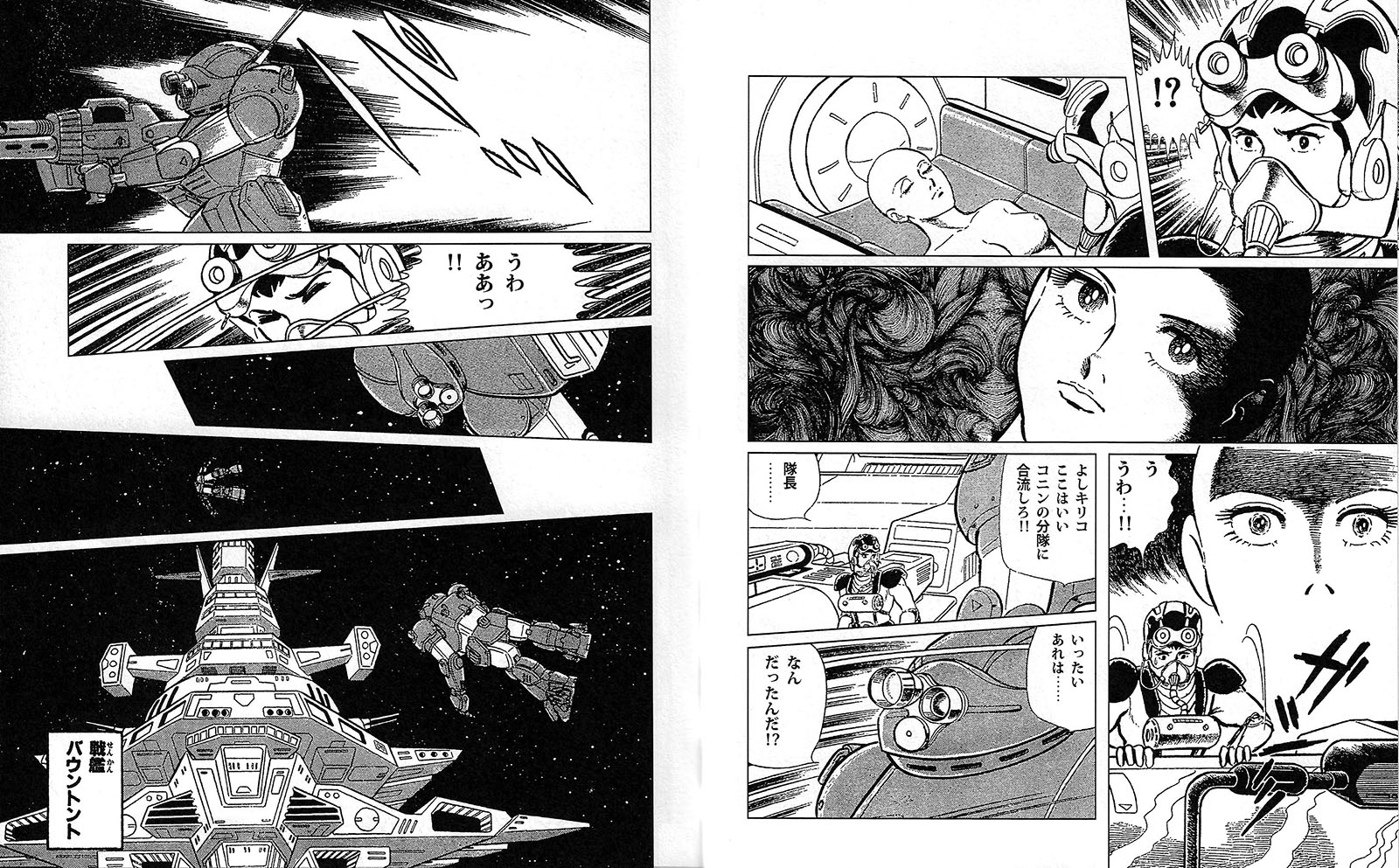
Paru: This one seems to have used more reference materials (than Nonaka’s version)…
(Everyone laughs)
Rin: It’s more faithful to the designs. (Laughs)
Nonaka: When did he draw it? I think mine came earlier.
Paru: Oh, really? This is part of the first episode, right?
Okazaki: Yes, the first episode.
Nonaka: Well, as Okazaki-san said earlier, it comes down to the number of pages, right? The number of days we had to work was different. (Everyone agrees).
Paru: Yes, that’s true.
Nonaka: Thirty or so pages [from me] and about ten or so pages [from him]…
Okazaki: Eight.
Nonaka: So you could have a time lag of about 10 days. The materials that came to us were different.
Paru: Yeah, but… I mean, it looks really faithful to the original. Going by the small mecha, it looks just like an image from the anime.
Nonaka: I’m amazed I got that much right the first time. I mean, when I got it, I only got the script for the first episode.
Endo: But the release date…there is a relationship, isn’t there?
Nonaka: BomBom was on the 15th, and… I wonder when the other one was.
Okazaki: We met at the preview, right?
Nonaka: Yes, we did.
Endo: I think it was on sale on the same day, wasn’t it?
Nonaka: I guess so. And when we met at the preview, I think you already had the materials. But Kodansha couldn’t get them.
Paru: Sounds like a complicated situation. (Laughs)
Nonaka: Kodansha finally developed a relationship with Sunrise after Gundam, right? Until then, they didn’t have a good relationship with Sunrise.
Paru: Oh, that makes sense.
Nonaka: So suddenly we could bring Sunrise’s works to BomBom. In the beginning, there wasn’t a cooperative system, so Kodansha couldn’t obtain any design materials. Because of this, the way the materials were distributed was strictly through personal relationships. I think the details were different. It could also be that Mr. Okazaki gave me a lot of materials.
(Everyone laughs)
Nonaka: Maybe he said, “It’s just Nonaka, so it’s OK”. (Laughs) But Okazaki-san’s work is very solid. It’s funny to say “back then,” but I think artists of his age and expertise were very well organized, really good at putting it all together. Just by reading that, you can see four episodes [in a single chapter]. He included a month’s worth of content each time.
Paru: Yes, that’s right. And it’s a very interesting story!
Nonaka: I was always like, “What should I do? I don’t know what’s going to happen next.” I usually think about the next part while I’m drawing.
Paru: That’s right! When you make it into a manga, you can’t do that, can you?
Okazaki: He has good instincts. I read the script ahead of time.
(Everyone laughs)
Nonaka: Oh, I see. I just thought you said, “No problem” and that would be it.
(Everyone laughs)
Nonaka: I wondered if Mr. Okazaki knew about everything before I did. How did he do so much? It’s a snap for him, isn’t it? I was always messing things up. (Laughs) I didn’t get to read ahead at all. I was drawing Votoms and working on Mospeada, I think. And I was probably working for Terebiland, too. I was doing a lot of different things. It’s difficult to remember each and every one of them…
Paru: I guess there must have been quite a lot.
Nonaka: That’s true. I received a lot of bad reviews from fans. Some said they liked me, others said they hated me. Did they come to you, Mr. Okazaki?
Okazaki: Yes, I got both. Some would say, “This is wrong.” (Laughs)
Paru: After all, comicalizing has circumstances going on behind the scenes. I feel like everyone needs to accept that somewhat…
Nonaka: I don’t expect the readers to understand what goes on behind the scenes, but when I’m drawing, if I’m told that something is “wrong,” well, it’s something that I decided with the editor.
Okazaki: That’s a problem, isn’t it?
Nonaka: Yeah, I’m both sorry and annoyed, to be honest.
Paru: But you really can’t be bothered with that…
Nonaka: No, really, you have to take care of each and every one of them. As a professional, I try to do my best each time. Even if you ask me now to remember those days, I would say that I did a good job on each and every one of them, but when I think about it all together, I don’t remember much. I was up all night, so it’s even more difficult…
Okazaki: My memory is gone, isn’t it? (Laughs)
(Everyone laughs)
Nonaka: When I woke up, I was refreshed and ready to move on to the next thing, so I could only see tomorrow. I couldn’t worry about what was already done. And then, when it came time to publish a book [collection] I looked at it and thought, “What the heck? Oh, no! This is not good. I have to do something about it.”
Paru: So you made some additions and corrections….
Nonaka: Yes, yes, I had to. And, of course, I looked at Okazaki’s [version], too, and I thought mine was terrible, even though I was doing my best each time. I thought, “This is rude to the readers, so I’m going to do something about it.” So I started adding to it.
Nonaka: But it’s a shame that Mr. Okazaki’s work wasn’t published in book form. Was the number of pages not enough?
Okazaki: Not enough, not enough. Because there were only eight at a time. (Laughs)
Paru: Did you have instructions from the editorial department to fill in Chirico’s hair solid black?
Okazaki: No, I had to decide everything myself. I only had a white copy…the design materials were white, so I didn’t know how to color them at all.
Paru: Well, under those circumstances, I guess…
Okazaki: Yeah, but I’m still in trouble if someone says, “That’s not right.” (Laughs)
Paru: I want people to understand that. Once you’ve drawn something, you can’t change it anymore.
Okazaki: Yes, yes.
Nonaka: That’s why I drew it in such a way that it was settled. In those days, a manga artist’s life depended on how well he or she could create a solid image.
Paru: It also tightens up the composition of the picture.
Nonaka: Yes.
Okazaki: So it just has to be black.
Nonaka: Yes. I don’t like empty white spaces, so I have to blacken them…
Okazaki: Or it looks like cutting corners.
Nonaka: Yes, yes.
Paru: Well, on the other hand, many of today’s manga have less solidity.
Nonaka: Screen tones have increased, right?
Paru: Yes. In exchange for the increase in screen tones…
Nonaka: Kids nowadays don’t have the courage to use solids. And the printing situation is also different. In those days, if you put in a screen tone, it might not print well.
Okazaki: Oh, it was so dirty!
Paru: Yeah, because the printing itself didn’t come out properly.
Nonaka: Well, there is a generation gap there. When I was a senior, the technology of “shaving” the screen tone was just starting to be developed.
Okazaki: It was shiny back then. (Laughs)
Nonaka: If you wanted it to look shiny, you had to erase it with white or something. I’m from the generation that started shaving back then.
[Translator’s note: this refers to selectively scraping some of the screen tone away to create white highlights.]
Nonaka: But I didn’t know what screen tone was until I went to Dynamic Pro. After all, screen tones were really not used that much. So when I looked at old manuscripts, I wondered why they were so…raw. You might think, “Well, they didn’t have screen tones,” but it was a printing situation.
Okazaki: And I hated it because it was expensive.
(Everyone laughs)
Nonaka: Oh, it was expensive, wasn’t it? It’s cheaper now, but it was so expensive that I couldn’t even think about it. So I would rather use a solid color, or shadows, or horizontal lines, and so on. So, maybe it looks a bit unrefined now, but if you think about it back then…
Paru: I see…
Nonaka: If only we had computers that worked so beautifully, like now.
Okazaki: Yeah, I can make screen tones on my computer now.
Paru: Mr. Nonaka, you had copy machine technology…
Nonaka: Yeah, I don’t want an assistant. I’ve used a few of them, but they weren’t very good. (Laughs)
(Everyone laughs)
Paru: It’s kind of like you already do it yourself…
Nonaka: Yeah, well…the demands are great, aren’t they? How much time off do you need per day, transportation, meals, everything. You know, “Can you work for that much?” There is a difference between Japan and other countries. In other countries, for example, “assistant” means “assistant pro.” If I ask you to draw a background, you can draw anything, because you’re a pro.
Here, some have no intention of becoming a manga artist. They might become a background specialist. If you want action lines, you get an action line specialist. If you want scriptwriting, you get a scriptwriting specialist. That’s a different kind of pro.
In Japan, there was an apprentice system, so you had to go through an apprenticeship, and then you would rise to the next level. You know, you’d watch the backs of your masters and seniors and gain on them.
Paru: Oh, you mean like following the back of your senpai (Okazaki)…
Nonaka: Yes, yes. That’s what the system was there for. At first, you’re an amateur, whether you draw backgrounds or whatever, right? It could be for a big company or a private company. They give you pocket money, you get meals, and you can practice and get better and better, and then they say, “Oh, we feel comfortable trusting you with all of our backgrounds.”
But nowadays, from the training stage, they tell you how much money and how many days off a week you have, and you ask how much you’ll be paid when you become a full-fledged worker. So, for example, while I’m working as an assistant, I get paid, right? If someone says to me, “You get 10,000,” it means that I am only worth 10,000. If he says, “You get 100,000,” then I’m worth 100,000. It’s up to the teacher to decide, not something the assistant can demand. Since we don’t do it that way now, from the very beginning, they ask for a salary of 200,000 or something like that. And, “Do you have an insurance plan?”
(Everyone laughs)
Paru: I feel like they should just get a regular job. (Laughs).
Nonaka: That’s why they teach that kind of thing in manga schools now. So many of them came to me like that, and it was so depressing. So I said to myself, “Well, I’m done with that,” as long as a bomb doesn’t go off. (Laughs) They would just shut up and do what I said. If I’d say, “Put tone here,” they’d just put it there. But I already have a Mac. I’m on my third Mac, and those three assistants have been enough. (Laughs)
Paru: That sounds much better.
Nonaka: much better. (Laughs) But it’s hard, isn’t it? It really shouldn’t be like that. I think there are kids who really want to work hard. But there are too many of them, and I can’t tell who are the good ones. So, I decided to stop doing that for a while. And then, when I get a little busier, I’d love for someone to come along who says, “I debuted in a magazine, and I’m already a pro, but unfortunately I don’t have a job right now…”
Paru: Well, at that level…
Nonaka: …you know how hard it is to be a manga artist, and you know that they ask you to do the impossible. “Yep, that’s how it is.” If you’re someone who understands that, even if I have to pay you a salary, it’s a good thing, because it doesn’t make it harder on me. I think I’ll just stop until I find someone like that.
Paru: Mr. Nonaka, how did you get involved in Comic BomBom? Did it start with Votoms?
Nonaka: No, there was some talk when they started the first issue, but I said I wanted to wait and see how it would go. “It’s a new magazine, so let me see how it goes.”
Paru: Oh, you could say that at that time.
Nonaka: No, it wasn’t like I was in a position to say it, I was just cocky.
(Everyone laughs)
Nonaka: I was talking to KoroKoro at the time, and I wondered if it would be a good idea to work on a KoroKoro project, so I thought, “Well, let me see how it goes for the time being.” Then KoroKoro asked me to do something for them, and it wasn’t what I had in mind. I wanted to do something like Treasure Island or Drifting Lives of Fifteen Boys or something like that. That wasn’t going to work, so I decided to see how it would go with BomBom.
I was asked to do a short story, and that’s how I got involved. It was related to Leiji Matsumoto’s Captain Harlock, and was called Infinite Orbit or something like that. I thought, “I can’t draw Matsumoto’s mecha.” I borrowed one of Mr. Matsumoto’s chief assistants and asked him to draw the backgrounds. So it was like, “Everything is real except the people.”
(Everyone Laughs)
Nonaka: Right after that, I thought, “Well, if I can draw this kind of mecha…” and I was asked to draw Votoms. I think it was right around that time that BomBom‘s circulation went up from 300,000 to 1 million copies. Those were the best days. Now it’s at 260,000. KoroKoro had 1.6 million. It’s as if the readers of BomBom went straight to Korokoro. It would be good if it was evenly distributed, but it’s not like that.
About the BomBom KC edition and the Daitosha edition of Votoms
(Mr. Okazaki picks up Mr. Nonaka’s edition of Votoms)
Nonaka: This is when I get the most nervous!
(Everyone laughs)
Nonaka: It’s crazy. (Laughs) I drew this when I thought no one was watching.
Paru: It’s quite different from the old BomBom comics. There are a lot of revisions.
Nonaka: Yeah…I only had a week, so that’s all I could do. It’s not enough.
Paru: But you did a lot of work even in one week.
Nonaka: This one, too (indicates the Daitosha edition) This was really a rush job. The 3D, too.
Paru: At first we thought you didn’t do that yourself. (Laughs) I don’t mean to be rude, but….
Nonaka: Well, I made it properly. I made one, rejected it, and this is the second one. The first one was made in collaboration with various people. It was a modern Votoms with a nice style. But it was too long. I said, “That’s not it!” I made it more like this and strengthened its tank image, and then reworked it a second time. So this is all of it.
Paru: I’m not sure what to say about manga artists who comicalize. You can draw anything, even mecha and people. I think that’s amazing.
Nonaka: Mr. Okazaki’s generation was the one that could draw anything. (Laughs) It’s all downhill from there. I’m really bad at this.
Okazaki: No, you’re not. (Laughs)
Nonaka: No, it’s true. There are parts that I have to rely on others to draw. But Mr. Okazaki can draw it by himself. Even if two artists come to the same assistant, the experience level is completely different. They did a lot of things. Even though I was called a background man, there were 13 of us in the room at that time, and I was the only one who drew people [in the background]. So, the artists who were with me and below me were even worse. But now it’s different. Now we all draw people.
(Everyone laughs)
Nonaka: Normally, if you think about it, doing 30 pages a month by yourself, that’s the limit. So I get suspicious of anyone who goes over 30 pages a month.
(Everyone laughs)
Nonaka: Yes, that’s the limit. How many could you do per month with a staff? 60?
Okazaki: The highest I’ve done is 100. With a background staff.
Nonaka: If I had a background staff, I could do 100 or so. I was also told by Go Nagai not to use an assistant until I could draw 100 pages by myself. So when I made my debut, I drew up to 100 pages by myself.
Paru: Oh, wow!
Nonaka: Then Mr. Sakurata said to me, “Idiot, why do you trust what Go says?”
(Everyone laughs)
Paru: I was thinking, “There’s no way you can do that…”.
Nonaka: According to Mr. Sakurata, the level of drawing was different then, so now it’s impossible to do 100 pages. Weekly magazines are also difficult. You can draw up to about 60 pages with people and backgrounds for a bi-weekly. If you go that far, the level is different. In the past, you didn’t have to put in tones, but that’s not sufficient now. So, I was told, “You can use other people if you can get up to 60.” But Mr. Ishikawa said, “Is that so? You can do anything you want from the beginning.”
(Everyone laughs)
Nonaka: But Mr. Okazaki said to me, “Don’t do anything other than manga, and don’t work part-time.”
Okazaki: No, I didn’t.
(Everyone laughs)
Paru: There’s something special about Mr. Okazaki’s Votoms…
Okazaki: Not really…it was just 8 pages at a time. (Laughs)
Paru: Really, it’s a comicalization, and it’s easily digestible.
Nonaka: You were pretty enthusiastic about it, weren’t you?
Okazaki: Yeah, it was more fun than Gundam. 8 pages at a time, 8 episodes or something like that, so only about 60 pages in total. [Translator’s note: he misremembers this total, it was a little over 100.]
Nonaka: When I first started drawing it, I didn’t know what I was doing. But I was told by the editor, “This will be your legacy,” And now that I look back on it, I realize that Votoms will always be with me. In a good way. Even now, Votoms is still a side dish for me to this day, and I want to do it to the end. It’s a work I would like to draw again. I think it’s worth it.
I’d like to see a collected volume of Mr. Okazaki’s work, if possible. I think it would be difficult to sell it commercially. So I’d like to put them together with my manga, but it would be strange if I start with Okazaki-san’s manga for eight episodes. So, I really want to see Okazaki’s version in one book. Maybe he could do another 20 pages or so.
Paru: A lot of old manuscripts that have been lost, so if you don’t have that kind of thing available…
Okazaki: Yes, I don’t have much of my art from Akita Shoten.
Paru: Akita Shoten, poor management.
Okazaki: Yeah, I mean, they didn’t return them.
Nonaka: I’d like to publish the Okazaki version as it is, and call it the Okazaki version.
Paru: In terms of design, the AT is special. Round, like an octopus, for example. What was your impression of the design?
Okazaki: Well, it was a hassle. I had to use a compass. (Laughs)
Paru: Oh, you had to be precise… I mean, in the drawing process…
Okazaki: It doesn’t move like in the anime, so it doesn’t look as cool.
Nonaka: I think Mr. Okazaki probably agrees that there are good poses in the anime where you don’t catch the cheating in the middle because the movement is continuous. But in manga, you have to stop the movement, right? So there’s a lot you can’t do in a drawing. That was tough. If I did it wrong, it would just be a solid body floating in midair. It was difficult until I got a model kit or a figure for the first time and I thought, “Wow, it’s like this?”
Paru: They had a very precise reproduction.
Nonaka: Yes, it was amazing. But that’s why I was in trouble. “Now that I’ve gone this far, what do I do?” Seriously. It was fine for people who didn’t know about it, but for those who did…I wasn’t sure what to do.
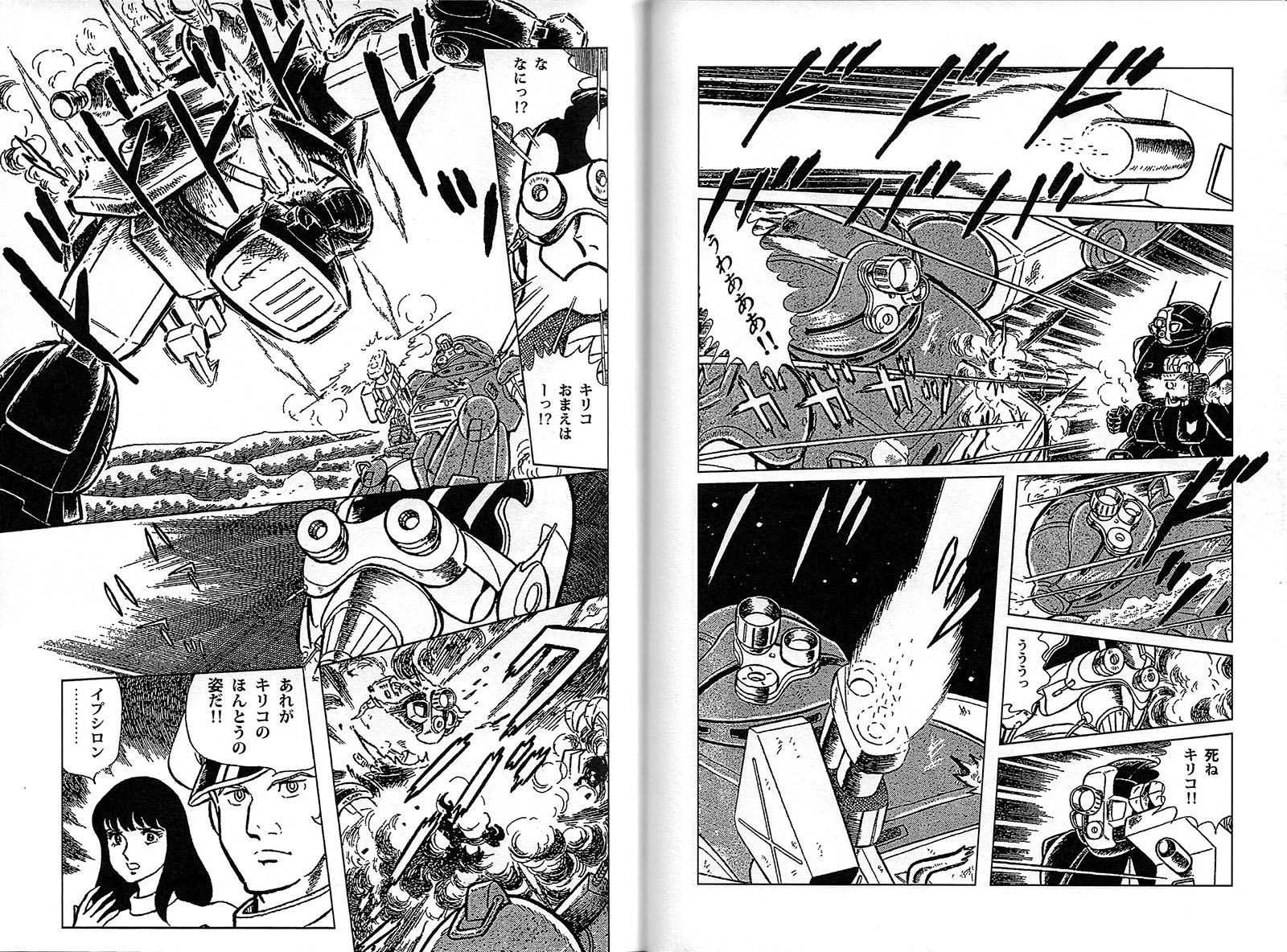
Ask Yu Okazaki!
Paru: Mr. Okazaki, did you watch TV back then?
Okazaki: Once in a while. I saw the first episode of Votoms at a preview screening.
Paru: Were you invited by Director Takahashi?
Okazaki: I don’t remember. (Laughs)
Paru: So at the time, you had a TV at home, and you were watching Votoms on it…
Okazaki: I might have watched it once in a while (Laughs)
Paru: And you thought, “Oh, I’m drawing this…”
Okazaki: Yeah, it had nice movement on TV. I liked the colors. For example, the eyes [of the AT] were like a camera. I wanted to express something like that, but I couldn’t.
Paru: Indeed, if it becomes a manga, you can only use a sound effect.
Okazaki: “Gasha,” or “Veeeen” for the zoom.
Paru: What was the reaction of the fans?
Okazaki: I didn’t get many fan letters back then.
Paru: Well, I guess compared to Daitarn 3 and Gundam…
Okazaki: Yes, yes, yes.
Paru: And the number of pages was small.
Endo: The magazine itself was quite minor.
Okazaki: So… I guess the one with the most fan letters was Daitarn 3 after all.
Paru: Was your page rate expensive or cheap at the time?
Okazaki: I don’t remember, but Akita Shoten was usually cheap. (Laughs)
(Everyone laughs)
Paru: How long did an episode take you to draw?
Okazaki: About a week.
Paru: Usually done by one person, wasn’t it?
Okazaki: Yes, that’s right.
Paru: What about your later work?
Okazaki: After Votoms, I comicalized tokasatsu programs like Bioman by Toei, or something like that, in the same category.
Paru: Sentai stuff…
Okazaki: Yes, the ones with five people. Red and yellow and so on. (Laughs)
Paru: Yeah, but what if it’s a manga?
Rin: The colors… (Laughs)
Okazaki: It’s even more difficult when you get many different colors (Laughs)
(Everyone laughs)
Paru: Same question to Mr. Nonaka. At the time, did you have TV or video at home?
Nonaka: Yes.
Paru: And you watched it?
Nonaka: Yes. I recorded everything that was on TV while I worked on it.
Paru: I don’t mean to be rude, but was the page rate high or low?
Nonaka: I don’t remember how much I was paid.
Okazaki: With cutlets.
(Everyone laughs)
Nonaka: I wonder how much it was. I think it was around 10,000 yen. I think they said it was higher than usual at that time…
Okazaki: That’s expensive. I didn’t get that much.
(Everyone laughs)
Paru: Well, Kodansha put more effort into it than Akita…
Nonaka: I think it was the same with Bouken Oh [magazine]. I think it was a flat page rate of 10,000 yen or 12,000 yen for everyone. I think it was 7,000 yen at the time of my debut. I remember it went up by 1,000 yen every year.
Paru: Like a pay raise seniority system…
Nonaka: Some people get a raise, some don’t, and some get a raise of just 500 yen a year, and some get 1,000 yen or 2,000 yen a year. It depends on the work. Maybe the [reprint] book sold well. So there are things like that. In the case of Bouken Oh, there was no book, so the page rate couldn’t be as high.
In the case of this one (Votoms), there was a book, and people were willing to pay for it, so I kept earning more. So, it’s logical to say that you can’t get money if you don’t have money. If you have money you can invest it, and money will come back to you.
Rin: Could you talk about the time you met with Director Takahashi?
Paru: I think that’s what Votoms fans would like to hear about. Did you actually communicate with Director Takahashi?
Nonaka: Yes, we met with the editor-in-chief of BomBom at that time, and he said, “Manga is manga, so do whatever you want to do.” TV and manga are two different things. You can’t do the same thing with manga as you can with TV, and vice versa. It’s fine if you do different things in different places. Isn’t it best if each person can do their own thing at their own post? Don’t think too much about it.
So when I said, “I want to know what’s going to happen next,” he said, “I don’t know.”
(Everyone laughs)
Nonaka: We ended the conversation by saying “Okay,” and that was pretty much it.
Paru: Meanwhile, Mr. Okazaki had already read ahead. (Laughs)
Nonaka: Yes. (Laughs)
Paru: His version was called an “SF Mystery,” right?
Nonaka: At first. BomBom was a little different…
Paru: BomBom‘s sales method was different, wasn’t it?
Nonaka: Yes. I drew a double-page spread for the teaser. It was very different.
Paru: Did you have in mind that the target age group was higher? You wrote it in the style of a children’s manga…
Okazaki: Most of the kanji were simplified with hiragana. Like “launch.”
Nonaka: Probably for third graders.
Okazaki: I think they used some sort of standard, such as kanji characters that were memorized by the third grade. And the lettering was so big… (Laughs)
Nonaka: The lettering was huge, wasn’t it?
Okazaki: I thought sooner or later I’d be told to write in katakana for the hiragana, too… (Laughs)
(Everyone laughs)
Nonaka: I can see how that might happen.
Paru: What kind of fan letters did you get, and what was your response?
Okazaki: I mostly wrote back.
Nonaka: Oh, you did?
Okazaki: Yeah.
Paru: Well, that’s what a manga artist is supposed to do…
Nonaka: Jeez, that puts me on the downside of the manga family. (Laughs)
Okazaki: They came to me with a return postcard. I felt bad if I didn’t write back. But then a child with an address close to yours might come around for a visit. (Laughs)
Nonaka: Well, I see… I guess you wrote carefully. I’ve never written back. Were you influenced by what readers said?
Okazaki: No, not really.
Nonaka: You’re a strong one. I’m no good. I’d be influenced left and right. “I want you to draw it this way, I want you to draw it that way.” That’s why I don’t read most of them until the project is finished. But one day when a thick one came, I was curious and opened it. I read it once, and then I read all the rest after the series was over. I accumulated a huge amount of letters.
I thought, “Oh, that’s what they were thinking.” I was like that when I wrote a series for a girl’s manga. I got a letter that said, “Please don’t kill the main character.” I thought, “Oh, I see you think I’m going to kill her.” (Laughs) But then I thought, “What AM I going to do?” So that’s why I don’t read fan letters. After it was over, I would send them all out in the form of New Year’s cards or something like that, saying “Thank you very much.”
(Everyone laughs)
Nonaka: I really don’t write replies. I don’t read them because I’m scared.
Okazaki: I throw away the complaints. (Laughs)
Nonaka: And the ones with too many complaints are hidden by the editorial department, right?
Okazaki: I don’t know about that.
Paru: Let’s take a look at something in Nonaka’s version. Shako’s hair was originally solid black, like Chirico’s.
Okazaki: As I said before, the design documents we got were just line drawings.
Nonaka: Also, there are times when the script was not a final draft.
Paru: Then, for example, this version of Rochina…
(Everyone laughs)
Paru: I was a bit shocked by this…
Nonaka: I met a guy named Toshiya Murakami, who was at Saito Pro. He was drawing Golgo 13 at that time, and he taught me how to draw. He told me this was the way to draw a villain’s face. I learned it from him, and it became what it is now.
(Everyone Laughs)
Paru: The image is like…
Okazaki: You had fun drawing it.
Nonaka: Yeah, I was often told to do it my own way. I was told that it shouldn’t be the same as on TV, and to make my own characters. And that’s what I learned from Murakami. Later, I thought, “This is wrong, isn’t it?”
Okazaki: It looks like Golgo, just on that page. (Laughs)
Nonaka: Yeah. I thought, “This is Golgo.” I didn’t know that when I was drawing it. I was just trying to make it look like Rochina.
Paru: Mr. Okazaki’s version is…quite faithful, isn’t it?
Nonaka: So, you see, Mr. Okazaki has already created his own drawings, right? So you can digest it. I haven’t been able to digest it at all these days.
Paru: This was the first time, isn’t it?
Nonaka: I was wondering what to do. But when you look here, it’s different, isn’t it?
Paru: The second volume. Oh, this is the re-release version. The face is totally different. It’s changed…
Nonaka: I think it would be even more different if I drew it now. I’ve been wondering about it for a long time. I thought I should redraw it once, whether it will be published in a book or not. So I drew a Battling scene and so on.
Paru: Here’s something I’ve been wondering for a while. Who was this person modeled after?
Nonaka: Which one?
Paru: There is this person who seems to have some significance.
Nonaka: That’s Onodera’s drawing. Not mine.
Paru: The crowd scene was drawn by an assistant?
Nonaka: Yeah, that’s probably Onodera. He’s on the far left, and I’m next to him. I think that’s probably me.
Paru: That was our guess. When we met you, my impression was that we were right.
Nonaka: Yes. I probably had a yakuza-style perm at that time.
Okazaki: (Laughs)
Nonaka: Onodera drew quite a lot. He did the covers for the BomBom books. I’m colorblind, I don’t know colors. So I had him paint them. I don’t know what colors to use. I’ve never painted with 4 colors, but Mr. Okazaki is good at coloring.
Paru: Another example is Kanjelman in the Kummen section. His face is different on each page…
Okazaki: (Laughs) You shouldn’t say that.
Nonaka: Well, you know… It’s difficult…. (Laughs)
Okazaki: my heart is very broken. (Laughs)
Nonaka: That’s also where the Saito Pro influence comes out.
Paru: That’s right. A little bit…
Nonaka: But as I said before, there was a time when I was taught by the staff member who draws Golgo, and I became more like Saito Pro. And when I was working in the same building as Yoshikazu Yasuhiko, he taught me things. It was a time when I was trying to create my own style, and I was influenced by many people while I was drawing. In the thick fan letter I mentioned earlier, it said, “Minoru Nonaka is six people, isn’t he?”
(Everyone laughs)
Nonaka: Each of the characters [in Minoru Nonaka] must stand for someone’s name. I mean, what kind of name could be that convenient? (Laughs) I wasn’t really able to create my own pictures at that time, so I was influenced by the people around me. If you meet Yasuichi Oshima, you become like Yasuichi Oshima, and so on. I really couldn’t fix my drawings, and I had to do something about it. On the other hand, I also tried to draw Tatsunoko pro works.
Paru: That’s a different atmosphere…
Nonaka: That’s the scary part of comicalizing. I had never reached the point where I could make something with my own taste. No matter how I tried, I was always changing things around and it was a mess. If I were to draw Votoms now, I would finally be able to approach Mr. Okazaki’s level. Now I think I can draw in my own way. Back then, I didn’t know what to do. I was told not to think too much about it.
It was the same when I was at Dynamic Pro. “Don’t think about it.” I was only doing what came out of me, based on my sensitibility. It’s not like I have a technique that’s backed up by my own feelings, it’s really just a sensibility. So, that’s what it’s all about. You have to have a strong will to win.
I especially admired Dynamic Pro, so no matter what I drew, it would be a Dynamic Pro image. Then, I had to take that out of the picture. I’d been influenced by Go Nagai since I was about 6 years old in elementary school, so I imitated him all the time. I had no basic foundation to make my own pictures.
Then I had to create an original image without that foundation. I wanted to keep it close to the source, and the editor said, “No, make it your original.” I was trying to figure out how to do it, and I was influenced by many people. So, it was really hard when I was drawing this, and looking back at it is the hardest part. Although the really hardest part is when Okazaki-san sees it again. (Laughs)
Paru: That’s exactly what dreams are all about.
Nonaka: Yes, yes. That’s why I want to redraw it with that meaning in mind. Now, I think I can make a work that will satisfy at least 6 out of 10 people.
Paru: I’d like to know about your work since Votoms, or rather, how you’ve been working since then.
Nonaka: Since Votoms? Well, you know, Votoms influenced me a lot. I was influenced by it when I was designing the character Mars in Cyber Cop. So, Cyber Cop‘s overlap with Votoms is quite strong.
Paru: Ah… That’s a surprising connection! I didn’t know that.
Nonaka: What I’ve been doing for a long time is gradually ripening inside me. It’s like a rebirth. So, if you compare Votoms and Mars, they’re like cousins. (Laughs)
Paru: I have three more questions. Which Votoms character do you have the most attachment to?
Okazaki: Which one….
Nonaka: What are you thinking, Mr. Okazaki?
Okazaki: I don’t remember. (Laughs)
Paru: I guess he doesn’t remember much because of the short time he was there….
Okazaki: I guess so…
Nonaka: I think it was the female characters that Mr. Okazaki was really into.
(Everyone laughs)
Nonaka: After all when we say “Yu Okazaki,” we think of female characters. That’s what I think he’s best at. I think Votoms was the first time he drew a bald woman.
Okazaki: That’s right. A smooth shaved head. (Laughs) And it’s difficult to draw without hair.
Nonaka: But, you know, of course…. Fyana, Coconna, and so on, I think that’s Mr. Okazaki’s thing. I think it shows his unique taste. So, when Fyana was still referred to as “Prototype body,” I was able to use the design drawing as a base…
Paru: Is that how it’s usually done?
Nonaka: Yeah, it’s very difficult to have a smooth head in a close-up. And if you have trouble drawing, a bald head looks funny. If it’s too long or too short, it looks wrong. It’s very difficult. I think this is especially true for Mr. Okazaki, whose specialty is female characters.
Paru: It’s certainly a delicate touch, isn’t it? What about you, Mr. Nonaka?
Nonaka: The character that left the biggest impression on me…surprisingly, it was Vanilla.
Paru: Yeah, Vanilla is pretty solid, isn’t he?
Nonaka: Vanilla was the easiest character for me to work with.
Rin: This is a little surprising.
Nonaka: I definitely thought something was up with that guy.
(Everyone laughs)
Nonaka: At the end, Chirico was the only one who went all out. I was thinking that Vanilla was, you know, being set up for something. There was always someone by Chirico’s side. Why would these three be by Chirico’s side all the time? I thought it was strange that they just randomly met each other. There must be something going on here, I thought.
And Vanilla can fix an A.T., right? So I kept on reading deeper into it, thinking that there must be something up with Vanilla. Until the very end. Eventually I thought, “It’s not going to happen!” I was really expecting it.
Paru: I was expecting some kind of a surprise at the end, too.
Nonaka: I was sure he would betray Chirico or something, and become a serious enemy. And because he’s usually such a goofy character, I thought that he would turn and become really sharp. I was waiting for that kind of development, but Vanilla is still there at the end.
Paru: When you do your original Votoms…please do that!
Nonaka: (Laughs)
Paru: Now then, since this [doujinshi] is a “Captain Kan Yu Special,” maybe you can share your thoughts on him.
Okazaki: Who is that? I don’t remember if I drew him. (Laughs)
Nonaka: I think you did.
Paru: (shows a Kan Yu scene to Okazaki-sensei) This is it.
Okazaki: Really? I drew the story, but I don’t know if I drew this guy or not. I remember drawing the swamp. (Laughs) You guys are gonna kill me. You’ll call me a senile old man. (Laughs)
Paru: How about you, Mr. Nonaka?
Nonaka: As far as Kan Yu is concerned, I was in deep with him as well as Vanilla.
Paru: I had a feeling that there was something about him, that he was smart…
Nonaka: But the editor said, “He definitely doesn’t matter.”
(Everyone laughs)
Nonaka: And he told me not to draw him too prominently, but I thought there must be something there. So the editor told me to kill him without a second thought in the scene where he dies. But I dropped him off a cliff. I was sure he would come back to life even if I dropped him. He didn’t come back to life.
(Everyone laughs)
Nonaka: So I made a fool of myself in the way I killed him. If characters die easily, they come back again most of the time. I was thinking, “He went so easily,” and I thought he would just reappear in a flash, but it ended so quickly after that. I guess I read it a little differently. Captain Kan Yu, I feel sorry for you. (Laughs)
(Everyone laughs)
Paru: well, in the anime, he’s a bit more stubborn… (Laughs) There’s a scene in the anime…in his first fight with Chirico, he falls off a cliff.
Nonaka: Oh yeah, that’s right.
Paru: That doesn’t appear in this manga. (Laughs)
Nonaka: You know, at the beginning, I was told not to depict him prominently because he wasn’t very relevant, so I drew him in a way that pushed him to the side. Since it was mainly for children, I had to focus on Chirico. With that in mind, I tried to avoid drawing Kan Yu for the most part. I thought, “Something’s going on,” but it was the opposite.
Okazaki: Two extremes (Laughs)
Nonaka: Yeah, that’s why I felt pity for the way he was killed. (Laughs) I think it would have been better if there had been something more. It must have been great, though, because it left a lasting impression on everyone.
Paru: No, we’re just weird. (Laughs) He’s not a significant character.
(Everyone laughs)
Nonaka: What about Gon Nu? The guy with one eye? I didn’t know if it was okay for him to have one eye like that. I was thinking, “Oh, this guy too…but it’s not possible with that body.” When I see such a smart character (like Kan Yu), I think, “There must be something there.”
Paru: Yes, in terms of smartness, he has something in common with Vanilla.
Nonaka: So in terms of movement, we have Chirico, Vanilla, Ypsilon, then Kan Yu. All of them are smart, right? I had a feeling those guys would make some kind of move later on. But then nothing happened. It was a little empty.
(Everyone laughs)
Nonaka: The other day I talked with someone who said she’s a fan of mine. And you know, first of all, everyone complains about Ypsilon. “What’s up with that feminine character?” Ypsilon’s design wasn’t decided in the beginning. When I drew it, I didn’t have any material. They asked me to draw him like a prince in a girl’s manga, so I drew him fluffy like that, and Sunrise said, “Yes, that’s it!”
Paru: Oh!
Nonaka: Apparently they used that.
Paru: So that means Ypsilon was based on your prototype.
Nonaka: They designed Ypsilon after seeing mine. If I was asked to participate in the project, I would have had a very different feeling about it. I would have been like, “Please don’t kill Ypsilon!” But I wanted to create an androgynous character, and the first time I drew it, I got a lot of complaints from readers. “What’s this?” I couldn’t change it because it was my idea at the beginning. But gradually, I started to move away from my own design and get closer to the TV version. But the fan said to me, “It’s the other way around. I wanted it to stay that way.”
Paru: Oh, she wanted you to stay with the same image.
Nonaka: Yeah, because that’s the way it was originally, that’s what I thought of. She wanted it to continue.
Paru: I see.
Nonaka: So, at the time of Votoms, it was a mess. Too much happened in one year!
(Everyone laughs)
Paru: That’s why you have such fond memories of it.
Nonaka: Yes.
Paru: It still haunts me somehow, the work itself…
Nonaka: Yes, in a good way. It has somehow become one of my masterpieces. I’m very grateful for that. I really need to show you something more solid if I get somehow get a chance.
Paru: That’s right.
Nonaka: There’s a bi-weekly magazine called Character Communication, right? I get to do 8 pages of manga in there.
Paru: That’s wonderful.
Nonaka: They told me to do whatever I wanted on the 8 pages, so I’m doing a lot of things. I wish I could do Votoms or something like that in it. But it’s difficult, isn’t it? Sunrise, you know.
Paru: Oh, I see.
Nonaka: I’m doing an original character there, and we’re hoping people will see it, and maybe even commercialize it. So, I thought I’d start with something that no one expected.
Paru: Okay, last question, which do you prefer, Fyana or Coconna?
Nonaka: Which one is my favorite, huh…?
Paru: Well, Mr. Okazaki drew them too…
Nonaka: Which do you like better?
Okazaki: I think Coconna was easier to draw. (Laughs)
(Everyone laughs)
Paru: And Mr. Nonaka?
Nonaka: I have feelings for both. But I don’t know which one I have more feelings for….
Paru: Which one would you want as a wife? (Laughs)
Nonaka: If I were to choose one as a wife…I wouldn’t want her to be bald. (Laughs)
(Everyone laughs)
Nonaka: I wondered which side Fyana was on. In the second half, I didn’t know until the end, and then I remembered it like, “Oh, yeah, that’s right.” But I thought, “If it were me, I would have gone more like this.” I wondered if it was okay to go that way, as a human emotion. In the beginning, I didn’t know who she was, so I just followed the script. But in the second half, I started to have doubts, and I thought, “I wonder if this should be different.” I started to have doubts about Chirico, too.
Paru: It’s like it got harder to grasp the character of Fyana.
Nonaka: I wondered if that movement was right in terms of the character’s emotions. I don’t know. As for Coconna, I guess it’s okay for that character to go the way she did. In the second half, I began to see (Fyana) as a character being manipulated by the story. I started to understand her true identity in the first part when she meets Chirico. I wondered if he had a different personality until he joined Red Shoulder, and then he met her as this complete stranger. She opens her eyes and Chirico is the first thing she sees…imprinting, right? That’s the way they input, but you start to feel differently about them midway through the story, don’t you?
From the point where they were wandering around in space in Battleship X, I had more and more doubts. I wondered if it was okay. Rather than feelings changing, I felt like their personality was changing. I think that the very fact that I had doubts was due to a change in personality, I think Fyana’s attachment was stronger than mine.
Paru: I see. So, as a character, she left an impression on you.
Nonaka: Up until the second half, I had been able to follow the story from the viewpoint of the characters’ emotions, but from there onward, I started to feel like I was being driven by the story. I think it was the creator’s idea to force the characters into a story that had to be told in a certain way.
It was different at the beginning, wasn’t it? The characters were surprised and did all kinds of things. I was able to see things as Chirico did. But from the middle of the story, I couldn’t see things from Chirico’s point of view. It became as if he was being driven by the larger picture of the story. I wondered if the story had changed midstream.
As it was, when Fyana opened her eyes, she saw Chirico and fell in love with him. And then there’s Ypsilon, who was in the same position. There were two people holding images of Chirico, who was supposed to be lonely, for some reason. Someone was chasing after him. I thought it would be okay to end it with Chirico going off into battle. So I wondered what happened. Why did they have to show that Chirico was such a specialist? Anyone could see that, you know.
I thought it would have been better to just make people think there was something special about him. I always wondered if it was necessary to put him in the same position as Fyana and Ypsilon. So, I would like to meet with Director Ryosuke (Takahashi) and talk about that if we were to do it again, so I could portray Chirico as a real human being while still following the TV version. But somewhere along the way, the axis will be different when he makes his turn.
I had a lot of doubts when I was drawing it. But since I was only in charge of the comicalization, I couldn’t say or draw that kind of thing. I just drew it with a lot of questions in my head.
Okazaki: Wow. You’ve been thinking about it for a long time. (Laughs) I just forgot about it. (Laughs)
Paru: It was over in two seconds for Mr. Okazaki.
Okazaki: It was the difference in the number of pages. (Laughs)
Nonaka: When the books came out, people told me that it was too long.
Okazaki: But you kept it in your head, right?
Nonaka: Yes. I’m slowly burying it. But then I say, “Remember, you have all the videos!” And then I watch it again, and I think, “Oh, it’s not the same!”
Paru: So you can see how you want to do it now, right?
Nonaka: Yes, yes. When it was over, I didn’t want to do anything more with it. I didn’t want to see it.
(Everyone laughs)
Nonaka: I thought, “I won’t get any more fan letters like this. Enough!” I was so happy when Radio Control Kid started after that.
(Everyone laughs)
Okazaki: “Oh, I can roll the character any way I want!”
Nonaka: Because of the restrictions, I can’t really express my feelings. It’s a contest of compositional skills, to be honest. If you’re a pro and have compositional skills, and if you can draw well, you can comicalize. I don’t want be stuck in that way of drawing. I want to put my feelings into my work. I want to say, “I love this” and draw it as if I created it myself. But there are some works that don’t let you do that.
Okazaki: Because you can’t see the future scripts. It’s very difficult to draw without knowing what’s going to happen next.
Nonaka: Yes, yes.
Paru: It must be stressful to draw something like that.
Nonaka: As I said before, there are deductive and inductive methods. You can guess where it’s going and go with it. In that process, all kinds of things happen. That’s the interesting part of the drama. The rest is random deduction. And even though it’s random, the producers have already decided on the general direction. It was very painful that they did not let us, the manga creators, know about it. It would have been nice if they’d said, “This is what we are going to do in the end.”
I couldn’t see it at all. You don’t have to know until halfway through, but I want you to tell me when you’ve figured it out. I didn’t understand until the very end. So as Chirico is working hard to get to the bottom of things, I’m thinking, “What the hell is this guy doing?” And in the end they went into the capsule, and then we were done, you know?
I thought, “Why is it like this?” So I reworked the manuscript of the final episode for the book. The last episode in BomBom was released about the same time as the book, so I made two versions at once. And then I watched the TV show and said, “Oh, no, it’s not the same!” It turned out to be different. I was forced to work without knowing what was going to happen next, so it didn’t turn out the way I wanted it to, and it was frustrating. I guess it was the same for Mr. Okazaki, too, because he couldn’t see what was going to happen next. And he only had eight pages, right?
Paru: Yeah, you can’t do much with eight pages.
Nonaka: But it’s a great technique to get it into those eight pages.
Paru: That’s how the story goes!
Okazaki: Four episodes in one month. (Laughs)
Nonaka: If you have a title page, you have to fit 4 episodes into just 7 pages, right? You can’t do it without great compositional skill.
Okazaki: Right. Two pages for one episode. (Laughs)
(Everyone laughs)
Nonaka: That’s way above the level I have to work at. I have to put it all together, and when they ask me to show my individuality, I say, “Are you kidding me?” It’s not about expressing individuality.
Paru: Indeed. You don’t have that kind of leeway.
Okazaki: Even if they say, “This is wrong.” (Laughs)
Nonaka: Hey. Even if they say, “This is wrong,” there’s nothing we can do about it.
Okazaki: You mean you want me to give you 100 pages?
Nonaka: I couldn’t have done it with less than that.
We continued to talk until late into the night about many things that were dangerous enough to shake up the industry. Mr. Okazaki and Mr. Nonaka did not show any displeasure at our amateurish approach, but laughed and indulged us. We apologize for any inconvenience we may have caused.
Thank you very much.

